Context-Aware Edge-Based AI Models for Wireless Sensor Networks—An Overview
Abstract
:1. Introduction
1.1. Our Contribution
- Apply a semantic-aware approach to identify survey-relevant subjects.
- Identify and explore various AI/ML and DL methods that can be used in the establishment of a context awareness setting of sensor networks.
- Analyze key challenges and the research gaps found in the literature that need to be solved.
- Discuss the motivations for integration of intelligent context awareness in wireless sensor networks.
- Outline future research directions.
1.2. Organization of This Work
2. Background and Related Work
2.1. Background
2.1.1. Context Awareness
2.1.2. Edge Computing
2.1.3. AI Disciplines
2.1.4. Wireless Sensor Network
2.2. Related Work
3. Methodology
3.1. Preparation of the Data
- IC1.
- Journal and conference papers that address the intersection between context-aware, artificial intelligence methods, and sensor network domain, containing the terms in the title, or keywords. Papers with the terms just in the abstract are excluded in this study.
- IC2.
- Papers available in electronic form published between 2015 and January 2022.
- IC3.
- Journal and conference papers written in English.
- EC1.
- Articles without access to the electronic file.
- EC2.
- Bibliographic, conference reviews, works of non-indexed or gray literature, and master thesis.
- EC3.
- Duplicate studies after reading the title.
- EC4.
- No relevance after reading title and abstract.
- Filter 1 allows the retention of papers related to context-awareness and AI fields such as ML and DL for sensor networks. The search takes the TITLE + ABSTRACT + KEYWORDS fields as a whole, making those 3 fields into just one and then running a text search (IC1).
- Filter 2 allows the retention of publications available in electronic form and published between 2015 and January 2022 (IC2). Articles without access to its electronic file are discarded (EC1).
- Filter 3 includes only publications journal and conference papers written in English (IC3). It also allows the removal of bibliographic, conference reviews, works of non-indexed or gray literature, and no research thesis (EC2).
- Filter 4 allows the removal of duplicate or redundant publications (EC3).
- Filter 5 allows the removal of irrelevant papers. The authors of the current survey have conducted this task by reviewing the title and abstract of each paper and selecting only papers that are related to the topic of the survey (EC4).
3.2. Search Conducting
3.3. Data Extraction and Analysis
- A total of 2760 publications related to context-awareness and AI fields were retrieved, of which, 1841 were obtained from Scopus and 919 from Web of Science.
- As a result of the second filter, 515 publications from Scopus and 380 publications from Web of Science were retrieved, available in electronic form and published between 2015 and January 2022 with access to its electronic file.
- Only publications in journals and conference papers written in English were retained. Bibliographic, conference reviews, etc., were excluded. Thus, 435 documents for Scopus and 328 for Web of Science were retrieved as a result of the third filter.
- After merging the publications of Scopus and Web of Science, 763 duplicate publications were removed in the fourth filter, and 490 left.
- After reading the title, abstract, and keywords of these publications, 349 were eliminated because they were not related to the topic of the survey. At the end of the fifth filter, 141 papers were left. These are included and examined in this work.
3.4. A Semantic-Aware Approach for Identifying the Survey Main Subjects
4. Result Analysis
4.1. Q1: How Much Literature Activity Has There Been between 2015 and January 2022?
4.2. Q2: What Are the Challenges in Context-Aware Edge-Based AI for Sensor Networks?
4.3. Q3: What Are the State-of-the-Art Solutions Used to Address the Challenges Depending on the Specific Application Field?
4.4. Q4: What Are the Motivations to Adopt AI Solutions to Context Awareness Scenario?
4.5. Q5: What Are the Limitations of Current Literature or What Are Gaps Existing in the Current Research about Applying AI Technologies to Context Awareness That Future Researchers Can Investigate?
5. Logistics Use Case: Industrial Perspectives, Challenges and Intelligent Techniques
6. Conclusions and Open Issues
Author Contributions
Funding
Institutional Review Board Statement
Informed Consent Statement
Data Availability Statement
Acknowledgments
Conflicts of Interest
Abbreviations
| AI | Artificial Intelligence |
| ANN | Artificial Neural Network |
| CNN | Convolution Neural Network |
| DF | Deep Forest |
| DL | Deep Learning |
| DNN | Deep Neural Network |
| DT | Decision Tree |
| EC | Edge Computing |
| ECG | Electrocardiogram |
| EEG | Electroencephalogram |
| ET | Extreme Trees |
| HAR | Human Activity Recognition |
| IoT | Internet of Things |
| IoMT | Internet of Mobile Things |
| GP | Gaussian Process |
| K-NN | K-Nearest Neighbors |
| LBS | Location Based Service |
| LR | Linear Regression |
| LSTM | Long Short-Term Memory |
| ML | Machine Learning |
| MLP | Multilayer Perceptron |
| NB | Naive Bayes |
| NN | Neural Networks |
| QoS | Quality of Service |
| RF | Random Forest |
| RL | Reinforcement Learning |
| RNN | Recurrent Neural Network |
| SGD | Stochastic Gradient Descent |
| SVM | Support Vector Machine |
| SVR | Support Vector Regression |
| SSL | Semi-Supervised Learning |
| WN | Wireless Network |
| WSN | Wireless Sensor Network |
References
- Mahdavinejad, M.S.; Rezvan, M.; Barekatain, M.; Adibi, P.; Barnaghi, P.; Sheth, A.P. Machine Learning for Internet of Things Data Analysis: A Survey. Digit. Commun. Netw. 2018, 4, 161–175. [Google Scholar] [CrossRef]
- Razzaque, M.A.; Milojevic-Jevric, M.; Palade, A.; Clarke, S. Middleware for Internet of Things: A Survey. IEEE Internet Things J. 2016, 3, 70–95. [Google Scholar] [CrossRef] [Green Version]
- Dastjerdi, A.V.; Buyya, R. Fog Computing: Helping the Internet of Things Realize Its Potential. Computer 2016, 49, 112–116. [Google Scholar] [CrossRef]
- Gubbi, J.; Buyya, R.; Marusic, S.; Palaniswami, M. Internet of Things (IOT): A Vision, Architectural Elements, and Future Directions. Future Gener. Comput. Syst. 2013, 29, 1645–1660. [Google Scholar] [CrossRef] [Green Version]
- Sakr, F.; Bellotti, F.; Berta, R.; De Gloria, A. Machine Learning on Mainstream Microcontrollers. Sensors 2020, 20, 2638. [Google Scholar] [CrossRef]
- Merenda, M.; Porcaro, C.; Iero, D. Edge Machine Learning for AI-Enabled IOT Devices: A Review. Sensors 2020, 20, 2533. [Google Scholar] [CrossRef]
- Li, Y.; Wang, S. An Energy-Aware Edge Server Placement Algorithm in Mobile Edge Computing. In Proceedings of the 2018 IEEE International Conference on Edge Computing (EDGE) 2018, San Francisco, CA, USA, 2–7 July 2018; pp. 66–73. [Google Scholar] [CrossRef]
- Wu, Z.; Su, L.; Huang, Q. Stacked Cross Refinement Network for Edge-Aware Salient Object Detection. In Proceedings of the 2019 IEEE/CVF International Conference on Computer Vision (ICCV) 2019, Seoul, Korea, 27 October–2 November 2019; pp. 7263–7272. [Google Scholar] [CrossRef]
- Khamis, S.; Fanello, S.; Rhemann, C.; Kowdle, A.; Valentin, J.; Izadi, S. Stereonet: Guided Hierarchical Refinement for Real-Time Edge-Aware Depth Prediction. In Proceedings of the European Conference on Computer Vision–ECCV 2018, Munich, Germany, 8–14 September 2018; pp. 596–613. [Google Scholar] [CrossRef] [Green Version]
- Yang, G.; Zhang, Q.; Zhang, G. EANet: Edge-Aware Network for the Extraction of Buildings from Aerial Images. Remote Sens. 2020, 12, 2161. [Google Scholar] [CrossRef]
- Kim, J.; Han, D.S.; Senouci, B. Radar and Vision Sensor Fusion for Object Detection in Autonomous Vehicle Surroundings. In Proceedings of the 2018 Tenth International Conference on Ubiquitous and Future Networks (ICUFN) 2018, Prague, Czech Republic, 3–6 July 2018; pp. 76–78. [Google Scholar] [CrossRef]
- Buzura, S.; Iancu, B.; Dadarlat, V.; Peculea, A.; Cebuc, E. Optimizations for Energy Efficiency in Software-Defined Wireless Sensor Networks. Sensors 2020, 20, 4779. [Google Scholar] [CrossRef]
- Wang, R.; Zhang, Z.; Zhang, Z.; Jia, Z. ETMRM: An Energy-Efficient Trust Management and Routing Mechanism for Sdwsns. Comput. Netw. 2018, 139, 119–135. [Google Scholar] [CrossRef]
- Junli, F.; Yawen, W.; Haibin, S. An Improved Energy-Efficient Routing Algorithm in Software Define Wireless Sensor Network. In Proceedings of the 2017 IEEE International Conference on Signal Processing, Communications and Computing (ICSPCC) 2017, Xiamen, China, 22–25 October 2017; pp. 1–5. [Google Scholar] [CrossRef]
- Shahraki, A.; Taherkordi, A.; Haugen, O.; Eliassen, F. A Survey and Future Directions on Clustering: From WSNS to IOT and Modern Networking Paradigms. IEEE Trans. Netw. Serv. Manag. 2021, 18, 2242–2274. [Google Scholar] [CrossRef]
- Buckley, T.; Ghosh, B.; Pakrashi, V. Edge Structural Health Monitoring (E-SHM) Using Low-Power Wireless Sensing. Sensors 2021, 21, 6760. [Google Scholar] [CrossRef] [PubMed]
- Álvarez, J.L.; Mozo, J.D.; Durán, E. Analysis of Single Board Architectures Integrating Sensors Technologies. Sensors 2021, 21, 6303. [Google Scholar] [CrossRef] [PubMed]
- Dey, A.K. Understanding and Using Context. Pers. Ubiquitous Comput. 2001, 5, 4–7. [Google Scholar] [CrossRef]
- Al-alshuhai, A.; Siewe, F. An Extension of the Use Case Diagram to Model Context-Aware Applications. In Proceedings of the 2015 SAI Intelligent Systems Conference (IntelliSys) 2015, London, UK, 10–11 November 2015; pp. 884–888. [Google Scholar] [CrossRef] [Green Version]
- Salber, D.; Dey, A.K.; Abowd, G.D. The Context Toolkit. In Proceedings of the SIGCHI Conference on Human Factors in Computing Systems the CHI Is the Limit-CHI ’99 1999, Pittsburgh, PA, USA, 15–20 May 1999; pp. 434–441. [Google Scholar] [CrossRef]
- Hoareau, C.; Satoh, I. Modeling and Processing Information for Context-Aware Computing: A Survey. New Gener. Comput. 2009, 27, 177–196. [Google Scholar] [CrossRef]
- El Ghazi, A.; Aarab, Z.; Ahiod, B. Context-Aware Routing Protocol Based on PSO for Mobile WSN. In Proceedings of the 2017 3rd International Conference of Cloud Computing Technologies and Applications (CloudTech) 2017, Rabat, Morocco, 24–26 October 2017; pp. 1–6. [Google Scholar] [CrossRef]
- Bajaj, K.; Sharma, B.; Singh, R. Implementation Analysis of IoT-Based Offloading Frameworks on Cloud/Edge Computing for Sensor Generated Big Data. Complex Intell. Syst. 2021, 1–18. [Google Scholar] [CrossRef]
- Yousefpour, A.; Fung, C.; Nguyen, T.; Kadiyala, K.; Jalali, F.; Niakanlahiji, A.; Kong, J.; Jue, J.P. All One Needs to Know about Fog Computing and Related Edge Computing Paradigms: A Complete Survey. J. Syst. Archit. 2019, 98, 289–330. [Google Scholar] [CrossRef]
- Pan, J.; McElhannon, J. Future Edge Cloud and Edge Computing for Internet of Things Applications. IEEE Internet Things J. 2018, 5, 439–449. [Google Scholar] [CrossRef]
- Sanchez, L.; Lanza, J.; Olsen, R.; Bauer, M.; Girod-Genet, M. A Generic Context Management Framework for Personal Networking Environments. In Proceedings of the 2006 Third Annual International Conference on Mobile and Ubiquitous Systems: Networking & Services 2006, San Jose, CA, USA, 17–21 July 2006; pp. 1–8. [Google Scholar] [CrossRef]
- Nilsson, N.J. Artificial Intelligence: A Modern Approach. Artif. Intell. 1996, 82, 369–380. [Google Scholar] [CrossRef] [Green Version]
- Kelleher, J.D. Deep Learning; MIT Press: Cambridge, MA, USA, 2019; pp. 1–2. [Google Scholar]
- Solomonoff, R.J. The Time Scale of Artificial Intelligence: Reflections on Social Effects. Hum. Syst. Manag. 1985, 5, 149–153. [Google Scholar] [CrossRef] [Green Version]
- Murphy, K.P. Machine Learning: A Probabilistic Perspective; MIT Press: Cambridge, MA, USA, 2021. [Google Scholar]
- Witten, I.H.; Hall, M.A.; Frank, E. Data Mining: Practical Machine Learning Tools and Techniques, 3rd ed.; Elsevier: Amsterdam, The Netherlands, 2011. [Google Scholar] [CrossRef] [Green Version]
- Patterson, J.; Gibson, A. Deep Learning: A Practitioner’s Approach; O’Reilly: Sebastopol, CA, USA, 2017. [Google Scholar]
- Li, S.; Kim, J.G. Maximizing the Lifetime of Wireless Sensor Networks with Random Forwarding. AEU-Int. J. Electron. Commun. 2015, 69, 455–457. [Google Scholar] [CrossRef]
- Noel, A.B.; Abdaoui, A.; Elfouly, T.; Ahmed, M.H.; Badawy, A.; Shehata, M.S. Structural Health Monitoring Using Wireless Sensor Networks: A Comprehensive Survey. IEEE Commun. Surv. Tutor. 2017, 19, 1403–1423. [Google Scholar] [CrossRef]
- Chitnis, S.; Deshpande, N.; Shaligram, A. An Investigative Study for Smart Home Security: Issues, Challenges and Countermeasures. Wirel. Sens. Netw. 2016, 8, 61–68. [Google Scholar] [CrossRef] [Green Version]
- Rashid, B.; Rehmani, M.H. Applications of Wireless Sensor Networks for Urban Areas: A Survey. J. Netw. Comput. Appl. 2016, 60, 192–219. [Google Scholar] [CrossRef]
- Shahraki, A.; Taherkordi, A.; Haugen, Ø.; Eliassen, F. Clustering Objectives in Wireless Sensor Networks: A Survey and Research Direction Analysis. Comput. Netw. 2020, 180, 107376. [Google Scholar] [CrossRef]
- Bajaj, K.; Sharma, B.; Singh, R. Integration of WSN with IOT Applications: A Vision, Architecture, and Future Challenges. In Integration of WSN and IoT for Smart Cities; Springer: Berlin/Heidelberg, Germany, 2020; pp. 79–102. [Google Scholar] [CrossRef]
- Jiang, P. A New Method for Node Fault Detection in Wireless Sensor Networks. Sensors 2009, 9, 1282–1294. [Google Scholar] [CrossRef] [PubMed] [Green Version]
- Perera, C.; Liu, C.H.; Jayawardena, S.; Chen, M. A Survey on Internet of Things from Industrial Market Perspective. IEEE Access 2014, 2, 1660–1679. [Google Scholar] [CrossRef]
- Alegre, U.; Augusto, J.C.; Clark, T. Engineering Context-Aware Systems and Applications: A Survey. J. Syst. Softw. 2016, 117, 55–83. [Google Scholar] [CrossRef]
- Vahdat-Nejad, H.; Asani, E.; Mahmoodian, Z.; Mohseni, M.H. Context-Aware Computing for Mobile Crowd Sensing: A Survey. Future Gener. Comput. Syst. 2019, 99, 321–332. [Google Scholar] [CrossRef]
- Miranda, L.; Viterbo, J.; Bernardini, F. A Survey on the Use of Machine Learning Methods in Context-Aware Middlewares for Human Activity Recognition. Artif. Intell. Rev. 2021, 55, 3369–3400. [Google Scholar] [CrossRef]
- Sezer, O.B.; Dogdu, E.; Ozbayoglu, A.M. Context-Aware Computing, Learning, and Big Data in Internet of Things: A Survey. IEEE Internet Things J. 2018, 5, 1–27. [Google Scholar] [CrossRef]
- Bogale, T.E.; Wang, X.; Le, L.B. Machine Intelligence Techniques for Next-Generation Context-Aware Wireless Networks. arXiv 2018, arXiv:1801.04223. [Google Scholar] [CrossRef]
- Pradeep, P.; Krishnamoorthy, S. The Mom of Context-Aware Systems: A Survey. Comput. Commun. 2019, 137, 44–69. [Google Scholar] [CrossRef]
- Liu, S.; Zhang, X.; Sun, X.; Yin, X.; Tang, R.; Jiang, Q. Survey on Context-Aware Systems and Their Applications. In Proceedings of the 2019 IEEE 9th International Conference on Electronics Information and Emergency Communication (ICEIEC) 2019, Beijing, China, 12–14 July 2019; pp. 234–237. [Google Scholar] [CrossRef]
- Chatterjee, B.; Cao, N.; Raychowdhury, A.; Sen, S. Context-Aware Intelligence in Resource-Constrained IOT Nodes: Opportunities and Challenges. IEEE Des. Test 2019, 36, 7–40. [Google Scholar] [CrossRef]
- del Carmen Rodríguez-Hernández, M.; Ilarri, S. AI-Based Mobile Context-Aware Recommender Systems from an Information Management Perspective: Progress and Directions. Knowl.-Based Syst. 2021, 215, 106740. [Google Scholar] [CrossRef]
- Rekik, R.; Kallel, I.; Casillas, J.; Alimi, A.M. Assessing Web Sites Quality: A Systematic Literature Review by Text and Association Rules Mining. Int. J. Inf. Manag. 2018, 38, 201–216. [Google Scholar] [CrossRef]
- Gupta, S.; Kar, A.K.; Baabdullah, A.; Al-Khowaiter, W.A.A. Big Data With Cognitive Computing: A Review for the Future. Int. J. Inf. Manag. 2018, 42, 78–89. [Google Scholar] [CrossRef]
- Boeva, V.; Boneva, L.; Tsiporkova, E. Semantic-Aware Expert Partitioning. In Artificial Intelligence: Methodology, Systems, and Applications; Springer: Cham, Switzerland, 2014; pp. 13–24. [Google Scholar] [CrossRef]
- Jaccard, P. Étude comparative de la distribution florale dans une portion des Alpes et du Jura. Bull. Soc. Vaudoise Sci. Nat. 1901, 37, 547–579. [Google Scholar] [CrossRef]
- Augustyniak, P.; Ślusarczyk, G. Graph-Based Representation of Behavior in Detection and Prediction of Daily Living Activities. Comput. Biol. Med. 2018, 95, 261–270. [Google Scholar] [CrossRef]
- Filippoupolitis, A.; Oliff, W.; Takand, B.; Loukas, G. Location-Enhanced Activity Recognition in Indoor Environments Using off the Shelf Smart Watch Technology and Ble Beacons. Sensors 2017, 17, 1230. [Google Scholar] [CrossRef] [Green Version]
- Esna Ashari, Z.; Chaytor, N.S.; Cook, D.J.; Ghasemzadeh, H. Memory-Aware Active Learning in Mobile Sensing Systems. IEEE Trans. Mob. Comput. 2020, 21, 181–195. [Google Scholar] [CrossRef]
- Bettini, C.; Civitarese, G.; Presotto, R. CAVIAR: Context-Driven Active and Incremental Activity Recognition. Knowl.-Based Syst. 2020, 196, 105816. [Google Scholar] [CrossRef]
- Alam, M.A.; Roy, N.; Holmes, S.; Gangopadhyay, A.; Galik, E. Autocognisys: IOT Assisted Context-Aware Automatic Cognitive Health Assessment. In Proceedings of the MobiQuitous 2020-17th EAI International Conference on Mobile and Ubiquitous Systems: Computing, Networking and Services 2020, Darmstadt, Germany, 7–9 December 2020; pp. 184–195. [Google Scholar] [CrossRef]
- Huang, H.; Zhou, P.; Li, Y.; Sun, F. A Lightweight Attention-Based CNN Model for Efficient Gait Recognition with Wearable IMU Sensors. Sensors 2021, 21, 2866. [Google Scholar] [CrossRef] [PubMed]
- Choksatchawathi, T.; Ponglertnapakorn, P.; Ditthapron, A.; Leelaarporn, P.; Wisutthisen, T.; Piriyajitakonkij, M.; Wilaiprasitporn, T. Improving Heart Rate Estimation on Consumer Grade Wrist-Worn Device Using Post-Calibration Approach. IEEE Sens. J. 2020, 20, 7433–7446. [Google Scholar] [CrossRef] [Green Version]
- Shaukat Jali, R.; Van Zalk, N.; Boyle, D. Detecting Subclinical Social Anxiety Using Physiological Data from a Wrist-Worn Wearable: A Small-Scale Feasibility Study. JMIR Form. Res. 2021, 5, e32656. [Google Scholar] [CrossRef]
- Paudel, P.; Kim, S.; Park, S.; Choi, K.-H. A Context-Aware IOT and Deep-Learning-Based Smart Classroom for Controlling Demand and Supply of Power Load. Electronics 2020, 9, 1039. [Google Scholar] [CrossRef]
- Chen, Z.; Chen, J.; Huang, X. An Activity-Aware Sampling Scheme for Mobile Phones in Activity Recognition. Sensors 2020, 20, 2189. [Google Scholar] [CrossRef]
- Yu, J.; Chen, Z.; Zhu, Y.; Chen, Y.; Kong, L.; Li, M. Fine-Grained Abnormal Driving Behaviors Detection and Identification with Smartphones. IEEE Trans. Mob. Comput. 2017, 16, 2198–2212. [Google Scholar] [CrossRef]
- Ehatisham-Ul-Haq, M.; Azam, M.A.; Amin, Y.; Naeem, U. C2fhar: Coarse-to-Fine Human Activity Recognition with Behavioral Context Modeling Using Smart Inertial Sensors. IEEE Access 2020, 8, 7731–7747. [Google Scholar] [CrossRef]
- Hauth, J.; Jabri, S.; Kamran, F.; Feleke, E.W.; Nigusie, K.; Ojeda, L.V.; Handelzalts, S.; Nyquist, L.; Alexander, N.B.; Huan, X.; et al. Automated Loss-of-Balance Event Identification in Older Adults at Risk of Falls during Real-World Walking Using Wearable Inertial Measurement Units. Sensors 2021, 21, 4661. [Google Scholar] [CrossRef]
- Lu, Y.; Zhang, S.; Zhang, Z.; Xiao, W.; Yu, S. A Framework for Learning Analytics Using Commodity Wearable Devices. Sensors 2017, 17, 1382. [Google Scholar] [CrossRef] [Green Version]
- Pejovic, V.; Musolesi, M. Anticipatory Mobile Computing: A Survey of the State of the Art and Research Challenges. ACM Comput. Surv. 2015, 47, 1–29. [Google Scholar] [CrossRef] [Green Version]
- Peleg, M.; Shahar, Y.; Quaglini, S.; Broens, T.; Budasu, R.; Fung, N.; Fux, A.; García-Sáez, G.; Goldstein, A.; González-Ferrer, A.; et al. Assessment of a Personalized and Distributed Patient Guidance System. Int. J. Med. Inform. 2017, 101, 108–130. [Google Scholar] [CrossRef] [PubMed] [Green Version]
- Rabbi, M.; Pfammatter, A.; Zhang, M.; Spring, B.; Choudhury, T. Automated Personalized Feedback for Physical Activity and Dietary Behavior Change with Mobile Phones: A Randomized Controlled Trial on Adults. JMIR mHealth uHealth 2015, 3, e4160. [Google Scholar] [CrossRef] [PubMed] [Green Version]
- Lane, N.D.; Georgiev, P. Can Deep Learning Revolutionize Mobile Sensing? In Proceedings of the 16th International Workshop on Mobile Computing Systems and Applications 2015, Santa Fe, NM, USA, 12–13 February 2015; pp. 117–122. [Google Scholar] [CrossRef] [Green Version]
- Ehatisham-ul-Haq, M.; Awais Azam, M.; Naeem, U.; Amin, Y.; Loo, J. Continuous Authentication of Smartphone Users Based on Activity Pattern Recognition Using Passive Mobile Sensing. J. Netw. Comput. Appl. 2018, 109, 24–35. [Google Scholar] [CrossRef] [Green Version]
- Zhou, X.; Liang, W.; Wang, K.I.-K.; Wang, H.; Yang, L.T.; Jin, Q. Deep-Learning-Enhanced Human Activity Recognition for Internet of Healthcare Things. IEEE Internet Things J. 2020, 7, 6429–6438. [Google Scholar] [CrossRef]
- Petrenko, A.; Kyslyi, R.; Pysmennyi, I. Detection of Human Respiration Patterns Using Deep Convolution Neural Networks. East.-Eur. J. Enterp. Technol. 2018, 4, 6–13. [Google Scholar] [CrossRef]
- Culman, C.; Aminikhanghahi, S.J.; Cook, D. Easing Power Consumption of Wearable Activity Monitoring with Change Point Detection. Sensors 2020, 20, 310. [Google Scholar] [CrossRef] [Green Version]
- Mehrotra, A.; Pejovic, V.; Musolesi, M. FutureWare: Designing a Middleware for Anticipatory Mobile Computing. IEEE Trans. Softw. Eng. 2021, 47, 2107–2124. [Google Scholar] [CrossRef] [Green Version]
- Jansson, J.; Hakala, I. Managing Sensor Data Streams in a Smart Home Application. Int. J. Sens. Netw. 2020, 32, 247. [Google Scholar] [CrossRef]
- Fujinami, K. On-Body Smartphone Localization with an Accelerometer. Information 2016, 7, 21. [Google Scholar] [CrossRef] [Green Version]
- Liang, Y.; Fan, H.W.; Fang, Z.; Miao, L.; Li, W.; Zhang, X.; Sun, W.; Wang, K.; He, L.; Chen, X.A. Oralcam: Enabling Self-Examination and Awareness of Oral Health Using a Smartphone Camera. In Proceedings of the 2020 CHI Conference on Human Factors in Computing Systems 2020, Honolulu, HI, USA, 25–30 April 2020; pp. 1–13. [Google Scholar] [CrossRef]
- Mohr, D.C.; Zhang, M.; Schueller, S.M. Personal Sensing: Understanding Mental Health Using Ubiquitous Sensors and Machine Learning. Annu. Rev. Clin. Psychol. 2017, 13, 23–47. [Google Scholar] [CrossRef] [PubMed] [Green Version]
- Bettini, C.; Civitarese, G.; Giancane, D.; Presotto, R. ProCAVIAR: Hybrid Data-Driven and Probabilistic Knowledge-Based Activity Recognition. IEEE Access 2020, 8, 146876–146886. [Google Scholar] [CrossRef]
- Peppas, K.; Tsolakis, A.C.; Krinidis, S.; Tzovaras, D. Real-Time Physical Activity Recognition on Smart Mobile Devices Using Convolutional Neural Networks. Appl. Sci. 2020, 10, 8482. [Google Scholar] [CrossRef]
- Liu, Y.; Wang, K.; Li, G.; Lin, L. Semantics-Aware Adaptive Knowledge Distillation for Sensor-to-Vision Action Recognition. IEEE Trans. Image Process. 2021, 30, 5573–5588. [Google Scholar] [CrossRef] [PubMed]
- Chung, S.; Lim, J.; Noh, K.J.; Kim, G.; Jeong, H. Sensor Data Acquisition and Multimodal Sensor Fusion for Human Activity Recognition Using Deep Learning. Sensors 2019, 19, 1716. [Google Scholar] [CrossRef] [PubMed] [Green Version]
- Alo, U.R.; Nweke, H.F.; Teh, Y.W.; Murtaza, G. Smartphone Motion Sensor-Based Complex Human Activity Identification Using Deep Stacked Autoencoder Algorithm for Enhanced Smart Healthcare System. Sensors 2020, 20, 6300. [Google Scholar] [CrossRef]
- Jackermeier, R.; Ludwig, B. Smartphone-Based Activity Recognition in a Pedestrian Navigation Context. Sensors 2021, 21, 3243. [Google Scholar] [CrossRef]
- Calabrese, B.; Velázquez, R.; Del-Valle-Soto, C.; de Fazio, R.; Giannoccaro, N.I.; Visconti, P. Solar-Powered Deep Learning-Based Recognition System of Daily Used Objects and Human Faces for Assistance of the Visually Impaired. Energies 2020, 13, 6104. [Google Scholar] [CrossRef]
- Ranjan, J.; Whitehouse, K. Towards Recognizing Person-Object Interactions Using a Single Wrist Wearable Device. In Proceedings of the 2016 ACM International Joint Conference on Pervasive and Ubiquitous Computing: Adjunct 2016, Heidelberg, Germany, 12–16 September 2016; pp. 722–731. [Google Scholar] [CrossRef] [Green Version]
- Boursalie, O.; Samavi, R.; Doyle, T.E. M4CVD: Mobile Machine Learning Model for Monitoring Cardiovascular Disease. Procedia Comput. Sci. 2015, 63, 384–391. [Google Scholar] [CrossRef] [Green Version]
- Rossier, F.; Lang, P.; Hennebert, J. Near Real-Time Appliance Recognition Using Low Frequency Monitoring and Active Learning Methods. Energy Procedia 2017, 122, 691–696. [Google Scholar] [CrossRef]
- Alotaibi, B. Transportation Mode Detection by Embedded Sensors Based on Ensemble Learning. IEEE Access 2020, 8, 145552–145563. [Google Scholar] [CrossRef]
- Akmandor, A.O.; Yin, H.; Jha, N.K. Smart, Secure, Yet Energy-Efficient, Internet-of-Things Sensors. IEEE Trans. Multi-Scale Comput. Syst. 2018, 4, 914–930. [Google Scholar] [CrossRef]
- Sliwa, B.; Adam, R.; Wietfeld, C. Client-Based Intelligence for Resource Efficient Vehicular Big Data Transfer in Future 6G Networks. IEEE Trans. Veh. Technol. 2021, 70, 5332–5346. [Google Scholar] [CrossRef]
- Marinakis, V. Big Data for Energy Management and Energy-Efficient Buildings. Energies 2020, 13, 1555. [Google Scholar] [CrossRef] [Green Version]
- Zhang, T.; Sodhro, A.H.; Luo, Z.; Zahid, N.; Nawaz, M.W.; Pirbhulal, S.; Muzammal, M. A Joint Deep Learning and Internet of Medical Things Driven Framework for Elderly Patients. IEEE Access 2020, 8, 75822–75832. [Google Scholar] [CrossRef]
- Gendy, M.E.; Al-Kabbany, A.; Badran, E.F. Green Crowdsensing with Comprehensive Reputation Awareness and Predictive Device-Application Matching Using a New Real-Life Dataset. IEEE Access 2020, 8, 225757–225776. [Google Scholar] [CrossRef]
- Saeed, U.; Lee, Y.-D.; Jan, S.; Koo, I. CAFD: Context-Aware Fault Diagnostic Scheme towards Sensor Faults Utilizing Machine Learning. Sensors 2021, 21, 617. [Google Scholar] [CrossRef]
- Dobbins, C.; Fairclough, S.; Lisboa, P.; Navarro, F.F. A Lifelogging Platform towards Detecting Negative Emotions in Everyday Life Using Wearable Devices. In Proceedings of the 2018 IEEE International Conference on Pervasive Computing and Communications Workshops (PerCom Workshops) 2018, Athens, Greece, 19–23 March 2018; pp. 306–311. [Google Scholar] [CrossRef]
- Wang, Y.; Yan, J.; Sun, Q.; Li, J.; Yang, Z. A Mobilenets Convolutional Neural Network for GIS Partial Discharge Pattern Recognition in the Ubiquitous Power Internet of Things Context: Optimization, Comparison, and Application. IEEE Access 2019, 7, 150226–150236. [Google Scholar] [CrossRef]
- Thiebault, A.; Huetz, C.; Pistorius, P.; Aubin, T.; Charrier, I. Animal-Borne Acoustic Data Alone Can Provide High Accuracy Classification of Activity Budgets. Anim. Biotelemetry 2021, 9, 1–16. [Google Scholar] [CrossRef]
- Yang, T.; Guo, P.; Liu, W.; Liu, X.; Hao, T. DeepPIRATES: A Training-Light PIR-Based Localization Method with High Generalization Ability. IEEE Access 2021, 9, 86054–86061. [Google Scholar] [CrossRef]
- Madoery, P.G.; Detke, R.; Blanco, L.; Comerci, S.; Fraire, J.A.; González-Montoro, A.M.; Bellassai, J.C.; Britos, G.M.; Ojeda, S.M.; Finochietto, J.M. Feature Selection for Proximity Estimation in COVID-19 Contact Tracing Apps Based on Bluetooth Low Energy (BLE). Pervasive Mob. Comput. 2021, 77, 101474. [Google Scholar] [CrossRef] [PubMed]
- Ferrari, L.; Dell’Acqua, F.; Zhang, P.; Du, P. Integrating EfficientNet into an Hafnet Structure for Building Mapping in High-Resolution Optical Earth Observation Data. Remote Sens. 2021, 13, 4361. [Google Scholar] [CrossRef]
- Healey, G.; Zhao, S. Measurement Space Partitioning for Estimation and Prediction. IEEE Access 2021, 9, 137419–137429. [Google Scholar] [CrossRef]
- Alghamdi, S.; Fadel, E.; Alowidi, N. Recognizing Activities of Daily Living Using 1d Convolutional Neural Networks for Efficient Smart Homes. Int. J. Adv. Comput. Sci. Appl. 2021, 12, 1–11. [Google Scholar] [CrossRef]
- Sukreep, S.; Elgazzar, K.; Chu, C.H.; Nukoolkit, C.; Mongkolnam, P. Recognizing Falls, Daily Activities, and Health Monitoring by Smart Devices. Sensors Mater. 2019, 31, 1847. [Google Scholar] [CrossRef]
- Seo, W.; Cha, S.; Kim, Y.; Huh, J.; Park, J. SLO-Aware Inference Scheduler for Heterogeneous Processors in Edge Platforms. ACM Trans. Archit. Code Optim. 2021, 18, 1–26. [Google Scholar] [CrossRef]
- Saeb, S.; Cybulski, T.R.; Kording, K.P.; Mohr, D.C. Scalable Passive Sleep Monitoring Using Mobile Phones: Opportunities and Obstacles. J. Med. Internet Res. 2017, 19. [Google Scholar] [CrossRef]
- Roor, R.; Hess, J.; Saveriano, M.; Karg, M.; Kirsch, A. Sensor Fusion for Semantic Place Labeling. In Proceedings of the 3rd International Conference on Vehicle Technology and Intelligent Transport Systems 2017, Porto, Portugal, 22–24 April 2017; pp. 121–131. [Google Scholar] [CrossRef] [Green Version]
- Hannink, J.; Kautz, T.; Pasluosta, C.F.; Gasmann, K.-G.; Klucken, J.; Eskofier, B.M. Sensor-Based Gait Parameter Extraction with Deep Convolutional Neural Networks. IEEE J. Biomed. Health Inform. 2017, 21, 85–93. [Google Scholar] [CrossRef] [Green Version]
- Zappatore, M.; Loglisci, C.; Longo, A.; Bochicchio, M.A.; Vaira, L.; Malerba, D. Trustworthiness of Context-Aware Urban Pollution Data in Mobile Crowd Sensing. IEEE Access 2019, 7, 154141–154156. [Google Scholar] [CrossRef]
- Magno, M.; Cavigelli, L.; Andri, R.; Benini, L. Ultra-Low Power Context Recognition Fusing Sensor Data from an Energy-Neutral Smart Watch. In Internet of Things. IoT Infrastructures; Springer: Cham, Switzerland, 2016; pp. 331–343. [Google Scholar] [CrossRef]
- Alqahtani, F.; Katsigiannis, S.; Ramzan, N. Using Wearable Physiological Sensors for Affect-Aware Intelligent Tutoring Systems. IEEE Sens. J. 2021, 21, 3366–3378. [Google Scholar] [CrossRef]
- Momeni, N.; Valdes, A.A.; Rodrigues, J.; Sandi, C.; Atienza, D. CAFS: Cost-Aware Features Selection Method for Multimodal Stress Monitoring on Wearable Devices. IEEE Trans. Biomed. Eng. 2022, 69, 1072–1084. [Google Scholar] [CrossRef] [PubMed]
- Stavropoulos, T.G.; Meditskos, G.; Lazarou, I.; Mpaltadoros, L.; Papagiannopoulos, S.; Tsolaki, M.; Kompatsiaris, I. Detection of Health-Related Events and Behaviours from Wearable Sensor Lifestyle Data Using Symbolic Intelligence: A Proof-of-Concept Application in the Care of Multiple Sclerosis. Sensors 2021, 21, 6230. [Google Scholar] [CrossRef] [PubMed]
- Di Corso, E.; Cerquitelli, T.; Apiletti, D. METATECH: Meteorological Data Analysis for Thermal Energy Characterization by Means of Self-Learning Transparent Models. Energies 2018, 11, 1336. [Google Scholar] [CrossRef] [Green Version]
- Han, H.J.; Labbaf, S.; Borelli, J.L.; Dutt, N.; Rahmani, A.M. Objective Stress Monitoring Based on Wearable Sensors in Everyday Settings. J. Med. Eng. Technol. 2020, 44, 177–189. [Google Scholar] [CrossRef]
- Sikder, A.K.; Aksu, H.; Uluagac, A.S. A Context-Aware Framework for Detecting Sensor-Based Threats on Smart Devices. IEEE Trans. Mob. Comput. 2020, 19, 245–261. [Google Scholar] [CrossRef] [Green Version]
- Islam, B.; Nirjon, S. Zygarde: Time-Sensitive On-Device Deep Inference and Adaptation on Intermittently-Powered Systems. Proc. Acm Interact. Mob. Wearable Ubiquitous Technol. 2020, 4, 1–29. [Google Scholar] [CrossRef]
- Janidarmian, M.; Roshan Fekr, A.; Radecka, K.; Zilic, Z. A Comprehensive Analysis on Wearable Acceleration Sensors in Human Activity Recognition. Sensors 2017, 17, 529. [Google Scholar] [CrossRef]
- Zhang, L.; Zhu, Y.; Jiang, M.; Wu, Y.; Deng, K.; Ni, Q. Body Temperature Monitoring for Regular COVID-19 Prevention Based on Human Daily Activity Recognition. Sensors 2021, 21, 7540. [Google Scholar] [CrossRef]
- Dipsis, N.; Stathis, K. A RESTful Middleware for AI Controlled Sensors, Actuators and Smart Devices. J. Ambient Intell. Humaniz. Comput. 2019, 11, 2963–2986. [Google Scholar] [CrossRef] [Green Version]
- Khowaja, S.A.; Yahya, B.N.; Lee, S.-L. CAPHAR: Context-Aware Personalized Human Activity Recognition Using Associative Learning in Smart Environments. Hum.-Centric Comput. Inf. Sci. 2020, 10, 1–35. [Google Scholar] [CrossRef]
- Xu, M.; Qian, F.; Zhu, M.; Huang, F.; Pushp, S.; Liu, X. Deepwear: Adaptive Local Offloading for on-Wearable Deep Learning. IEEE Trans. Mob. Comput. 2020, 19, 314–330. [Google Scholar] [CrossRef] [Green Version]
- Munoz-Organero, M. Outlier Detection in Wearable Sensor Data for Human Activity Recognition (HAR) Based on Drnns. IEEE Access 2019, 7, 74422–74436. [Google Scholar] [CrossRef]
- Aldaz, G.; Puria, S.; Leifer, L.J. Smartphone-Based System for Learning and Inferring Hearing Aid Settings. J. Am. Acad. Audiol. 2016, 27, 732–749. [Google Scholar] [CrossRef] [PubMed] [Green Version]
- Samyoun, S.; Shubha, S.S.; Sayeed Mondol, M.A.; Stankovic, J.A. IWash: A Smartwatch Handwashing Quality Assessment and Reminder System with Real-Time Feedback in the Context of Infectious Disease. Smart Health 2021, 19, 100171. [Google Scholar] [CrossRef] [PubMed]
- Alharbi, M.; Karimi, H.A. Context-Aware Sensor Uncertainty Estimation for Autonomous Vehicles. Vehicles 2021, 3, 721–735. [Google Scholar] [CrossRef]
- Mendez, J.; Molina, M.; Rodriguez, N.; Cuellar, M.P.; Morales, D.P. Camera-Lidar Multi-Level Sensor Fusion for Target Detection at the Network Edge. Sensors 2021, 21, 3992. [Google Scholar] [CrossRef]
- Mugumya, K.L.; Wong, J.Y.; Chan, A.; Yip, C.-C.; Ghazy, S. Indoor Haze Particulate Control Using Knowledge Graphs within Self-Optimizing HVAC Control Systems. In IOP Conference Series: Earth and Environmental Science; IOP Publishing: Bristol, UK, 2020; Volume 489, p. 012006. [Google Scholar] [CrossRef]
- Chakkor, S.; Baghouri, M.; Cheker, Z.; el Oualkadi, A.; el Hangouche, J.A.; Laamech, J. Intelligent Network for Proactive Detection of COVID-19 Disease. In Proceedings of the 2020 6th IEEE Congress on Information Science and Technology (CiSt) 2020, Agadir, Essaouira, Morocco, 5–12 June 2021; pp. 472–478. [Google Scholar] [CrossRef]
- Santamaria-Granados, L.; Mendoza-Moreno, J.F.; Chantre-Astaiza, A.; Munoz-Organero, M.; Ramirez-Gonzalez, G. Tourist Experiences Recommender System Based on Emotion Recognition with Wearable Data. Sensors 2021, 21, 7854. [Google Scholar] [CrossRef]
- De Brouwer, M.; Ongenae, F.; Bonte, P.; De Turck, F. Towards a Cascading Reasoning Framework to Support Responsive Ambient-Intelligent Healthcare Interventions. Sensors 2018, 18, 3514. [Google Scholar] [CrossRef] [Green Version]
- Qian, K.; Koike, T.; Yoshiuchi, K.; Schuller, B.W.; Yamamoto, Y. Can Appliances Understand the Behavior of Elderly via Machine Learning? A Feasibility Study. IEEE Internet Things J. 2021, 8, 8343–8355. [Google Scholar] [CrossRef]
- Khodabandehloo, E.; Riboni, D.; Alimohammadi, A. HealthXAI: Collaborative and Explainable AI for Supporting Early Diagnosis of Cognitive Decline. Future Gener. Comput. Syst. 2021, 116, 168–189. [Google Scholar] [CrossRef]
- Koldijk, S.; Neerincx, M.A.; Kraaij, W. Detecting Work Stress in Offices by Combining Unobtrusive Sensors. IEEE Trans. Affect. Comput. 2018, 9, 227–239. [Google Scholar] [CrossRef] [Green Version]
- Schiboni, G.; Suarez, J.C.; Zhang, R.; Amft, O. DynDSE: Automated Multi-Objective Design Space Exploration for Context-Adaptive Wearable IOT Edge Devices. Sensors 2020, 20, 6104. [Google Scholar] [CrossRef] [PubMed]
- Dzemydienė, D.; Burinskienė, A. Integration of Context Awareness in Smart Service Provision System Based on Wireless Sensor Networks for Sustainable Cargo Transportation. Sensors 2021, 21, 5140. [Google Scholar] [CrossRef] [PubMed]
- Orsini, G.; Posdorfer, W.; Lamersdorf, W. Saving Bandwidth and Energy of Mobile and IOT Devices with Link Predictions. J. Ambient Intell. Humaniz. Comput. 2020, 12, 8229–8240. [Google Scholar] [CrossRef]
- Nascimento, N.; Alencar, P.; Lucena, C.; Cowan, D. An IOT Analytics Embodied Agent Model Based on Context-Aware Machine Learning. In Proceedings of the 2018 IEEE International Conference on Big Data (Big Data) 2018, Seattle, WA, USA, 10–13 December 2018; pp. 5170–5175. [Google Scholar] [CrossRef] [Green Version]
- Esmaeili Kelishomi, A.; Garmabaki, A.H.S.; Bahaghighat, M.; Dong, J. Mobile User Indoor-Outdoor Detection through Physical Daily Activities. Sensors 2019, 19, 511. [Google Scholar] [CrossRef] [Green Version]
- Lydia, E.L.; Jovith, A.A.; Devaraj, A.F.; Seo, C.; Joshi, G.P. Green Energy Efficient Routing with Deep Learning Based Anomaly Detection for Internet of Things (IOT) Communications. Mathematics 2021, 9, 500. [Google Scholar] [CrossRef]
- Chaib Draa, I.; Niar, S.; Tayeb, J.; Grislin, E.; Desertot, M. Sensing User Context and Habits for Run-Time Energy Optimization. Eurasip J. Embed. Syst. 2017, 4, 1–19. [Google Scholar] [CrossRef] [Green Version]
- Zhang, Y.; Srivastava, A.K.; Cook, D. Machine Learning Algorithm for Activity-Aware Demand Response Considering Energy Savings and Comfort Requirements. IET Smart Grid 2020, 3, 730–737. [Google Scholar] [CrossRef]
- Rivera, S.; Mendoza-Schrock, O.; Diehl, A. Transfer Learning for Aided Target Recognition: Comparing Deep Learning to other Machine Learning Approaches. arXiv 2020, arXiv:2011.12762. [Google Scholar] [CrossRef]
- Fenza, G.; Gallo, M.; Loia, V.; Marino, D.; Orciuoli, F. A Cognitive Approach Based on the Actionable Knowledge Graph for Supporting Maintenance Operations. In Proceedings of the 2020 IEEE Conference on Evolving and Adaptive Intelligent Systems (EAIS) 2020, Bari, Italy, 27–29 May 2020; pp. 1–7. [Google Scholar] [CrossRef]
- Turner, C.J.; Emmanouilidis, C.; Tomiyama, T.; Tiwari, A.; Roy, R. Intelligent Decision Support for Maintenance: An Overview and Future Trends. Int. J. Comput. Integr. Manuf. 2019, 32, 936–959. [Google Scholar] [CrossRef]
- Xu, R.; Jin, W.; Hong, Y.; Kim, D.-H. Intelligent Optimization Mechanism Based on an Objective Function for Efficient Home Appliances Control in an Embedded Edge Platform. Electronics 2021, 10, 1460. [Google Scholar] [CrossRef]
- Ruiz, A.R.; Alises, D.V.; Navarro, R.C.; Santofimia Romero, M.J.; Chaparro, J.D.; López López, J.C. Leveraging Commonsense Reasoning towards a Smarter Smart Home. Procedia Comput. Sci. 2021, 192, 666–675. [Google Scholar] [CrossRef]
- D’Eusanio, A.; Simoni, A.; Pini, S.; Borghi, G.; Vezzani, R.; Cucchiara, R. Multimodal Hand Gesture Classification for the Human–Car Interaction. Informatics 2020, 7, 31. [Google Scholar] [CrossRef]
- Mocanu, B.; Tapu, R.; Zaharia, T. When Ultrasonic Sensors and Computer Vision Join Forces for Efficient Obstacle Detection and Recognition. Sensors 2016, 16, 1807. [Google Scholar] [CrossRef] [Green Version]
- Waldner, F.; Diakogiannis, F.I. Deep Learning on Edge: Extracting Field Boundaries from Satellite Images with a Convolutional Neural Network. Remote Sens. Environ. 2020, 245, 111741. [Google Scholar] [CrossRef]
- Dalmazzo, D.; Ramirez, R. Air Violin: A Machine Learning Approach to Fingering Gesture Recognition. In Proceedings of the 1st ACM SIGCHI International Workshop on Multimodal Interaction for Education 2017, Glasgow, UK, 13 November 2017; pp. 63–66. [Google Scholar] [CrossRef] [Green Version]
- Kim, Y.; Imani, M.; Rosing, T.S. Efficient Human Activity Recognition Using Hyperdimensional Computing. In Proceedings of the 8th International Conference on the Internet of Things 2018, Santa Barbara, CA, USA, 15–18 October 2018; pp. 1–6. [Google Scholar] [CrossRef]
- Bhatia, Y.; Bari, A.S.M.H.; Hsu, G.-S.J.; Gavrilova, M. Motion Capture Sensor-Based Emotion Recognition Using a Bi-Modular Sequential Neural Network. Sensors 2022, 22, 403. [Google Scholar] [CrossRef]
- Ao, B.; Wang, Y.; Liu, H.; Li, D.; Song, L.; Li, J. Context Impacts in Accelerometer-Based Walk Detection and Step Counting. Sensors 2018, 18, 3604. [Google Scholar] [CrossRef] [Green Version]
- Angrisano, A.; Bernardi, M.L.; Cimitile, M.; Gaglione, S.; Vultaggio, M. Identification of Walker Identity Using Smartphone Sensors: An Experiment Using Ensemble Learning. IEEE Access 2020, 8, 27435–27447. [Google Scholar] [CrossRef]
- Zhao, R.; Yan, R.; Wang, J.; Mao, K. Learning to Monitor Machine Health with Convolutional Bi-Directional LSTM Networks. Sensors 2017, 17, 273. [Google Scholar] [CrossRef]
- Zhou, Y.; Hong, S.; Shang, J.; Wu, M.; Wang, Q.; Li, H.; Xie, J. Addressing Noise and Skewness in Interpretable Health-Condition Assessment by Learning Model Confidence. Sensors 2020, 20, 7307. [Google Scholar] [CrossRef]
- Hitimana, E.; Bajpai, G.; Musabe, R.; Sibomana, L.; Kayalvizhi, J. Implementation of IOT Framework with Data Analysis Using Deep Learning Methods for Occupancy Prediction in a Building. Future Internet 2021, 13, 67. [Google Scholar] [CrossRef]
- Giménez-Gallego, J.; González-Teruel, J.D.; Soto-Valles, F.; Jiménez-Buendía, M.; Navarro-Hellín, H.; Torres-Sánchez, R. Intelligent Thermal Image-Based Sensor for Affordable Measurement of Crop Canopy Temperature. Comput. Electron. Agric. 2021, 188, 106319. [Google Scholar] [CrossRef]
- Chadwick, A.J.; Coops, N.C.; Bater, C.W.; Martens, L.A.; White, B. Species Classification of Automatically Delineated Regenerating Conifer Crowns Using RGB and near-Infrared UAV Imagery. IEEE Geosci. Remote Sens. Lett. 2022, 19, 1–5. [Google Scholar] [CrossRef]
- Tazarv, A.; Labbaf, S.; Reich, S.M.; Dutt, N.; Rahmani, A.M.; Levorato, M. Personalized Stress Monitoring Using Wearable Sensors in Everyday Settings. In Proceedings of the 2021 43rd Annual International Conference of the IEEE Engineering in Medicine & Biology Society (EMBC) 2021, Guadalajara, Mexico, 1–5 November 2021; pp. 7332–7335. [Google Scholar] [CrossRef]
- Xie, W.; Ide, J.; Izadi, D.; Banger, S.; Walker, T.; Ceresani, R.; Spagnuolo, D.; Guagliano, C.; Diaz, H.; Twedt, J. Multi-Object Tracking with Deep Learning Ensemble for Unmanned Aerial System Applications. In Proceedings of the Artificial Intelligence and Machine Learning in Defense Applications III 2021, Proc. SPIE 11870, Online, 12 September 2021. [Google Scholar] [CrossRef]
- Stach, C.; Giebler, C.; Wagner, M.; Weber, C.; Mitschang, B. AMNESIA: A Technical Solution towards GDPR-Compliant Machine Learning. In Proceedings of the 6th International Conference on Information Systems Security and Privacy 2020, Valletta, Malta, 25–27 February 2020; pp. 21–32. [Google Scholar] [CrossRef]
- Wang, Z.; Li, Y.; Li, D.; Li, M.; Zhang, B.; Huang, S.; He, W. Enabling Fairness-Aware and Privacy-Preserving for Quality Evaluation in Vehicular Crowdsensing: A Decentralized Approach. Secur. Commun. Networks 2021, 2021, 1–11. [Google Scholar] [CrossRef]
- Hoong Ong, K.S.; Niyato, D.; Yuen, C. Predictive Maintenance for Edge-Based Sensor Networks: A Deep Reinforcement Learning Approach. In Proceedings of the 2020 IEEE 6th World Forum on Internet of Things (WF-IoT) 2020, New Orleans, LA, USA, 2–16 June 2020; pp. 1–6. [Google Scholar] [CrossRef]
- Zhou, Y.; Chen, Y.; Ma, Y.; Liu, H. A Real-Time Dual-Microphone Speech Enhancement Algorithm Assisted by Bone Conduction Sensor. Sensors 2020, 20, 5050. [Google Scholar] [CrossRef]
- Ali, R.; Ashraf, I.; Bashir, A.K.; Zikria, Y.B. Reinforcement-Learning-Enabled Massive Internet of Things for 6G Wireless Communications. IEEE Commun. Stand. Mag. 2021, 5, 126–131. [Google Scholar] [CrossRef]
- Musaddiq, A.; Nain, Z.; Ahmad Qadri, Y.; Ali, R.; Kim, S.W. Reinforcement Learning-Enabled Cross-Layer Optimization for Low-Power and Lossy Networks under Heterogeneous Traffic Patterns. Sensors 2020, 20, 4158. [Google Scholar] [CrossRef]
- Khan, A.; Umar, A.I.; Munir, A.; Shirazi, S.H.; Khan, M.A.; Adnan, M. A QoS-Aware Machine Learning-Based Framework for AMI Applications in Smart Grids. Energies 2021, 14, 8171. [Google Scholar] [CrossRef]
- Galindez, L.; Badami, K.; Vlasselaer, J.; Meert, W.; Verhelst, M. Dynamic Sensor-Frontend Tuning for Resource Efficient Embedded Classification. IEEE J. Emerg. Sel. Top. Circuits Syst. 2018, 8, 858–872. [Google Scholar] [CrossRef]
- Zhang, Y.; Gu, T.; Zhang, X. MDLdroid: A Chainsgd-Reduce Approach to Mobile Deep Learning for Personal Mobile Sensing. In Proceedings of the 2020 19th ACM/IEEE International Conference on Information Processing in Sensor Networks (IPSN) 2020, Sydney, Australia, 21–24 April 2020; pp. 73–84. [Google Scholar] [CrossRef]
- Fabian, P.; Rachedi, A. Dynamic Selection of Relays Based on Classification of Mobility Profile in a Highly Mobile Context. In Proceedings of the ICC 2020-2020 IEEE International Conference on Communications (ICC), Dublin, Ireland, 7–11 June 2020; pp. 1–6. [Google Scholar] [CrossRef]
- Masinelli, G.; Forooghifar, F.; Arza, A.; Atienza, D.; Aminifar, A. Self-Aware Machine Learning for Multimodal Workload Monitoring during Manual Labor on Edge Wearable Sensors. IEEE Des. Test 2020, 37, 58–66. [Google Scholar] [CrossRef]
- Gonzalez, J.A.; Cheah, L.A.; Gomez, A.M.; Green, P.D.; Gilbert, J.M.; Ell, S.R.; Moore, R.K.; Holdsworth, E. Direct Speech Reconstruction from Articulatory Sensor Data by Machine Learning. IEEE/ACM Trans. Audio Speech Lang. Process. 2017, 25, 2362–2374. [Google Scholar] [CrossRef] [Green Version]
- Singh, A.D.; Sandha, S.S.; Garcia, L.; Srivastava, M. RadHAR: Human Activity Recognition from Point Clouds Generated through a Millimeter-wave Radar. In Proceedings of the 3rd ACM Workshop on Millimeter-wave Networks and Sensing Systems-mmNets’19 2019, Los Cabos, Mexico, 25 October 2019; pp. 51–56. [Google Scholar] [CrossRef]
- Yin, Y.; Zhang, Y.; Liu, Z.; Liang, Y.; Wang, S.; Shah, R.R.; Zimmermann, R. Learning Multi-Context Aware Location Representations from Large-Scale Geotagged Images. In Proceedings of the 29th ACM International Conference on Multimedia 2021, Chengdu, China, 20–24 October 2021; pp. 899–907. [Google Scholar] [CrossRef]
- Al-Saedi, A.A.; Boeva, V.; Casalicchio, E. Reducing Communication Overhead of Federated Learning through Clustering Analysis. In Proceedings of the 2021 IEEE Symposium on Computers and Communications (ISCC) 2021, Athens, Greece, 5–8 September 2021; pp. 1–7. [Google Scholar] [CrossRef]
- Warnat-Herresthal, S.; Schultze, H.; Lingadahalli Shastry, K.; Manamohan, S.; Mukherjee, S.; Garg, V.; Sarveswara, R.; Handler, K.; Pickkers, P.; Netea, M.G.; et al. Swarm Learning for Decentralized and Confidential Clinical Machine Learning. Nature 2021, 594, 265–270. [Google Scholar] [CrossRef] [PubMed]
- Rodrigue, J.-P. The Geography of Transport Systems; Routledge, Taylor & Francis Group: London, UK, 2020. [Google Scholar] [CrossRef]
- Zhu, Y.; Luo, H.; Wang, Q.; Zhao, F.; Ning, B.; Ke, Q.; Zhang, C. A Fast Indoor/Outdoor Transition Detection Algorithm Based on Machine Learning. Sensors 2019, 19, 786. [Google Scholar] [CrossRef] [Green Version]
- Hare, J.Z.; Gupta, S.; Song, J.; Wettergren, T.A. Classification induced distributed sensor scheduling for energy-efficiency in underwater target tracking sensor networks. In Proceedings of the OCEANS 2017, Anchorage, AK, USA, 18–21 September 2017; pp. 1–7. [Google Scholar]
- Woschank, M.; Rauch, E.; Zsifkovits, H. A Review of Further Directions for Artificial Intelligence, Machine Learning, and Deep Learning in Smart Logistics. Sustainability 2020, 12, 3760. [Google Scholar] [CrossRef]
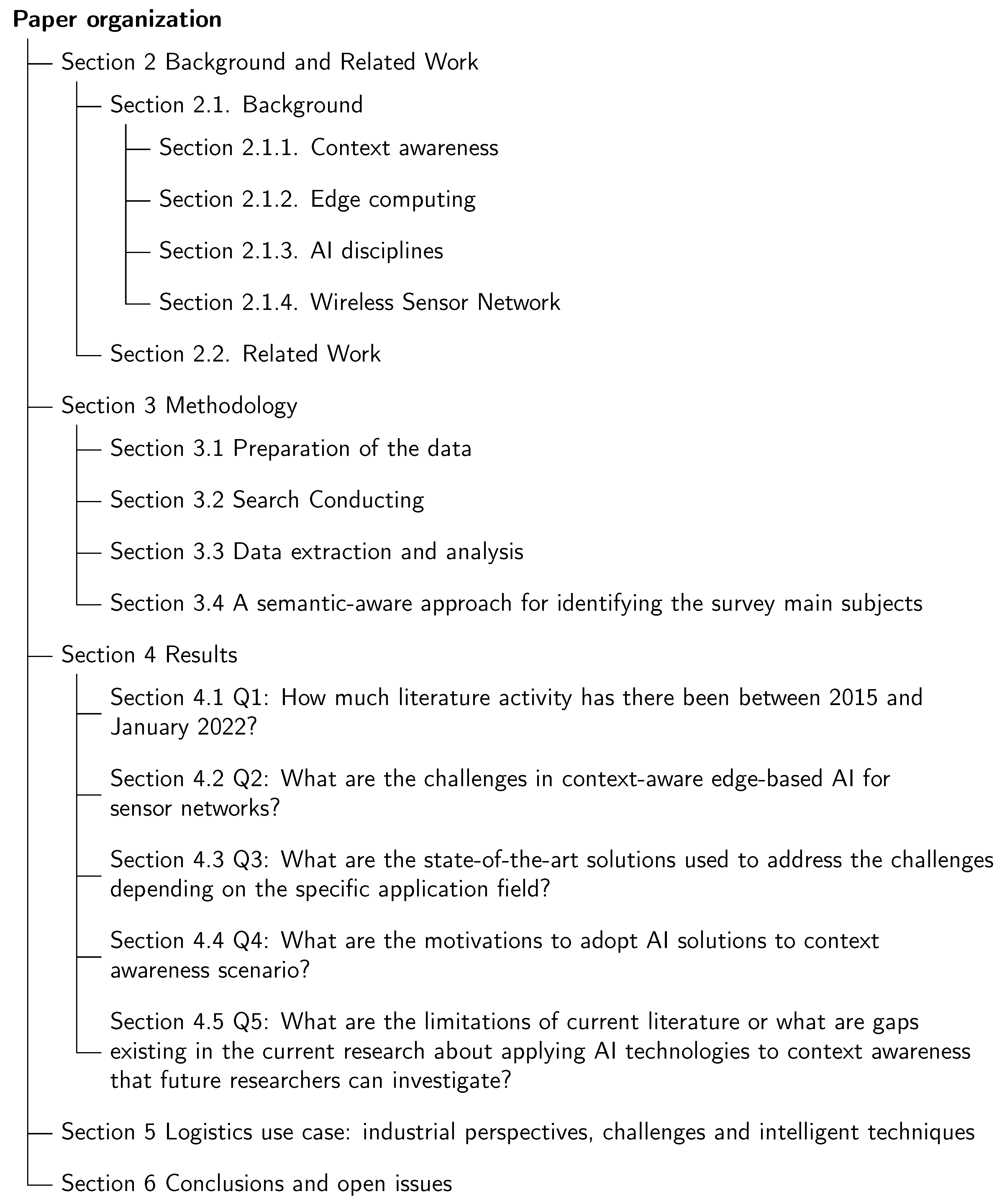
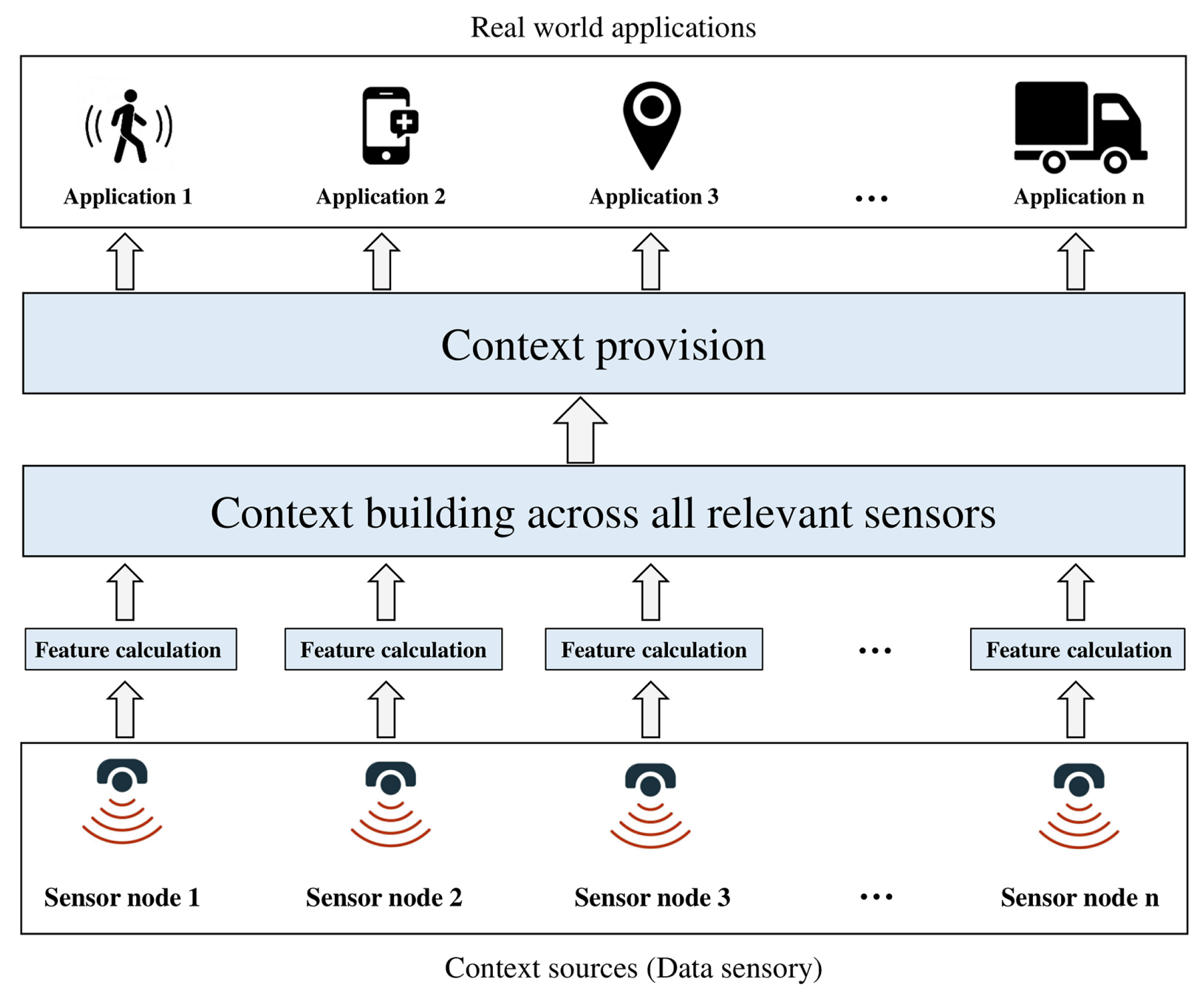
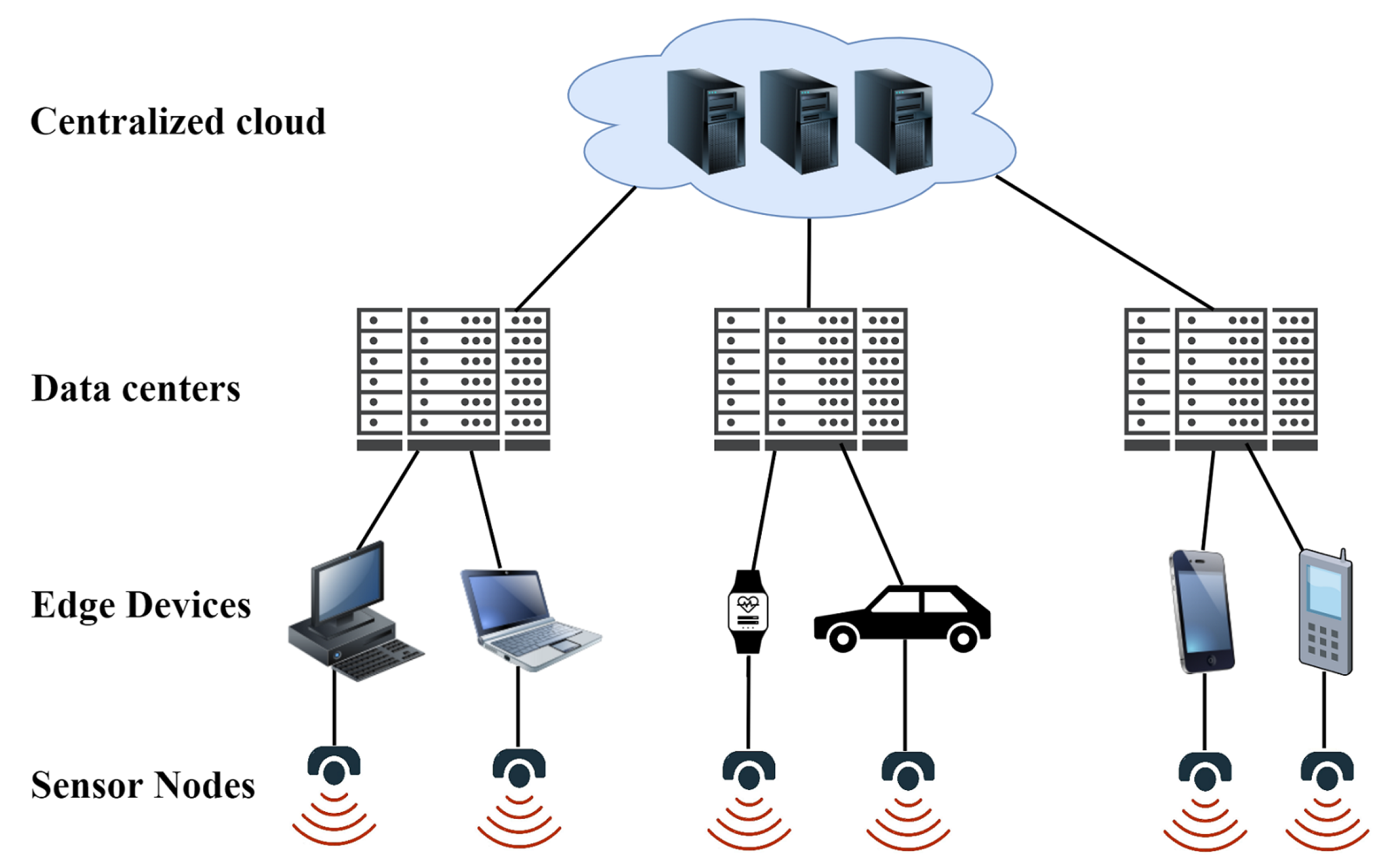


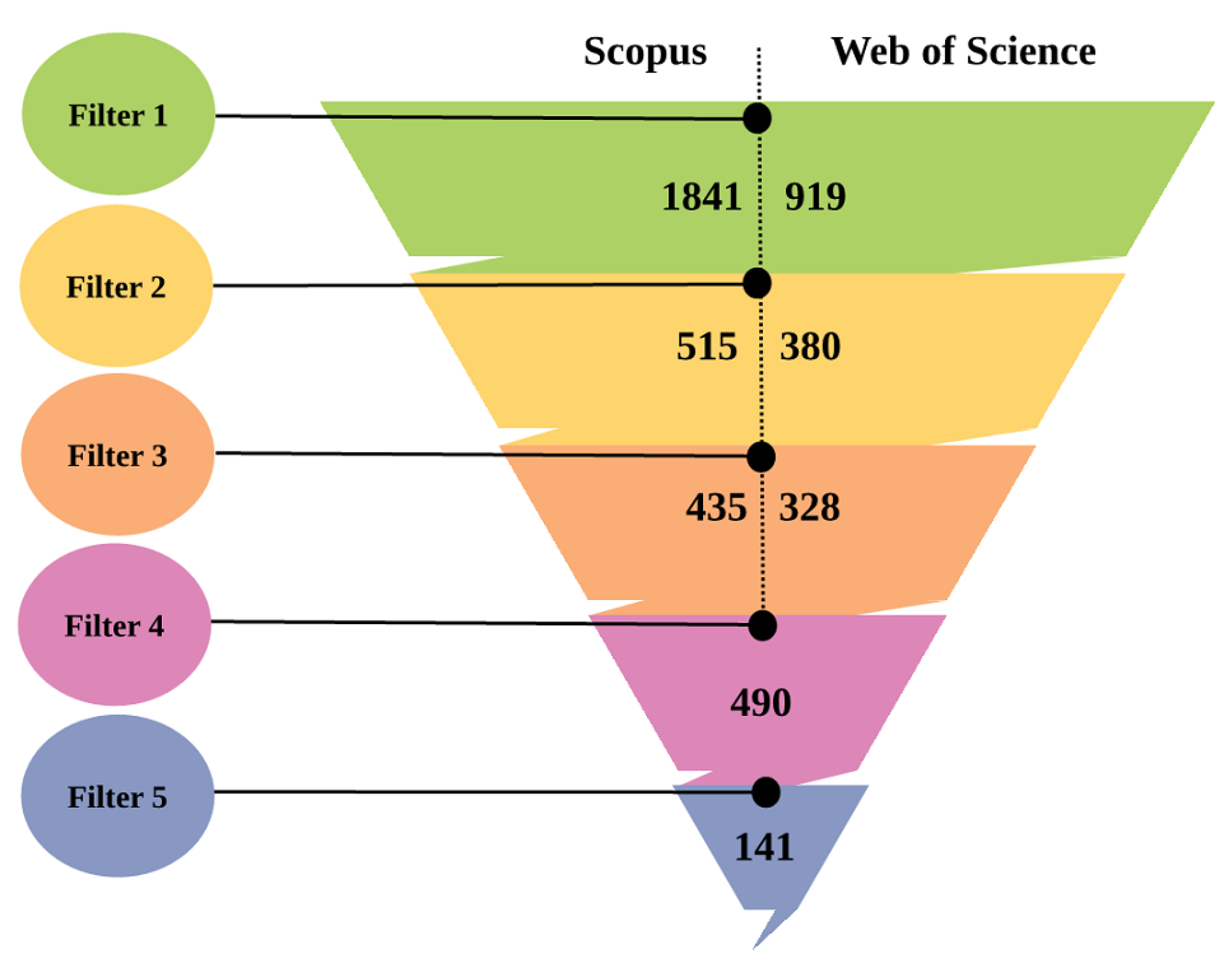

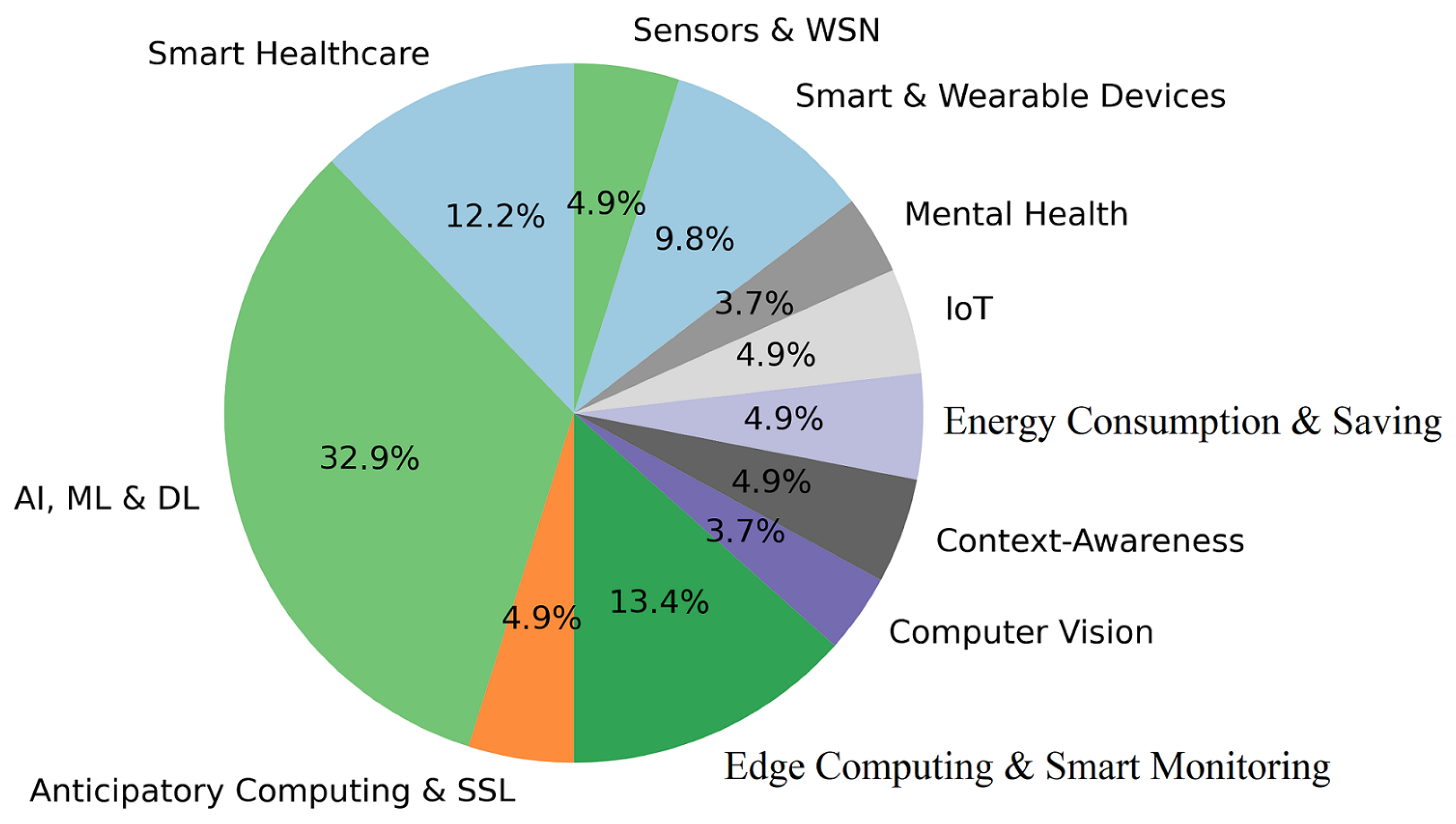
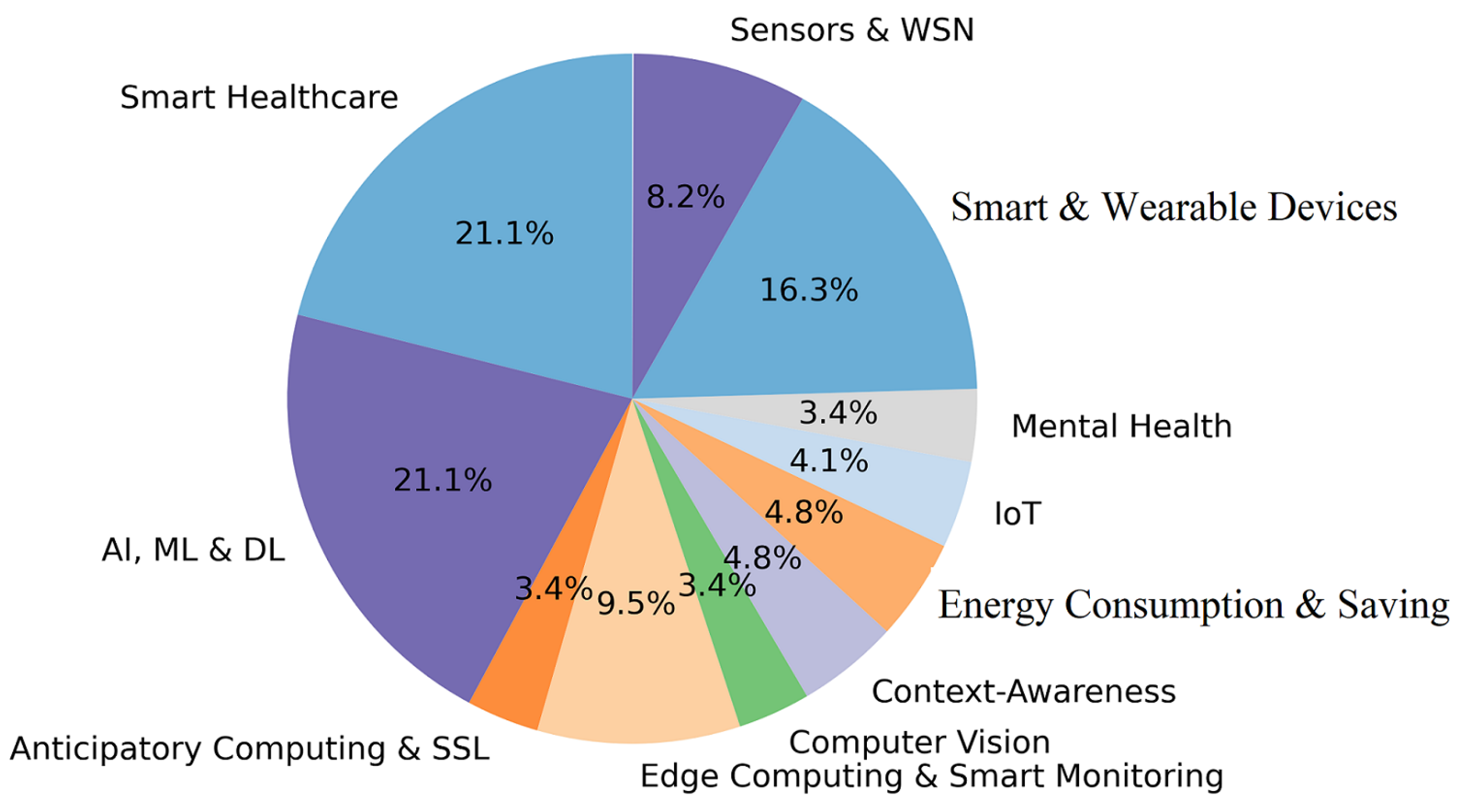

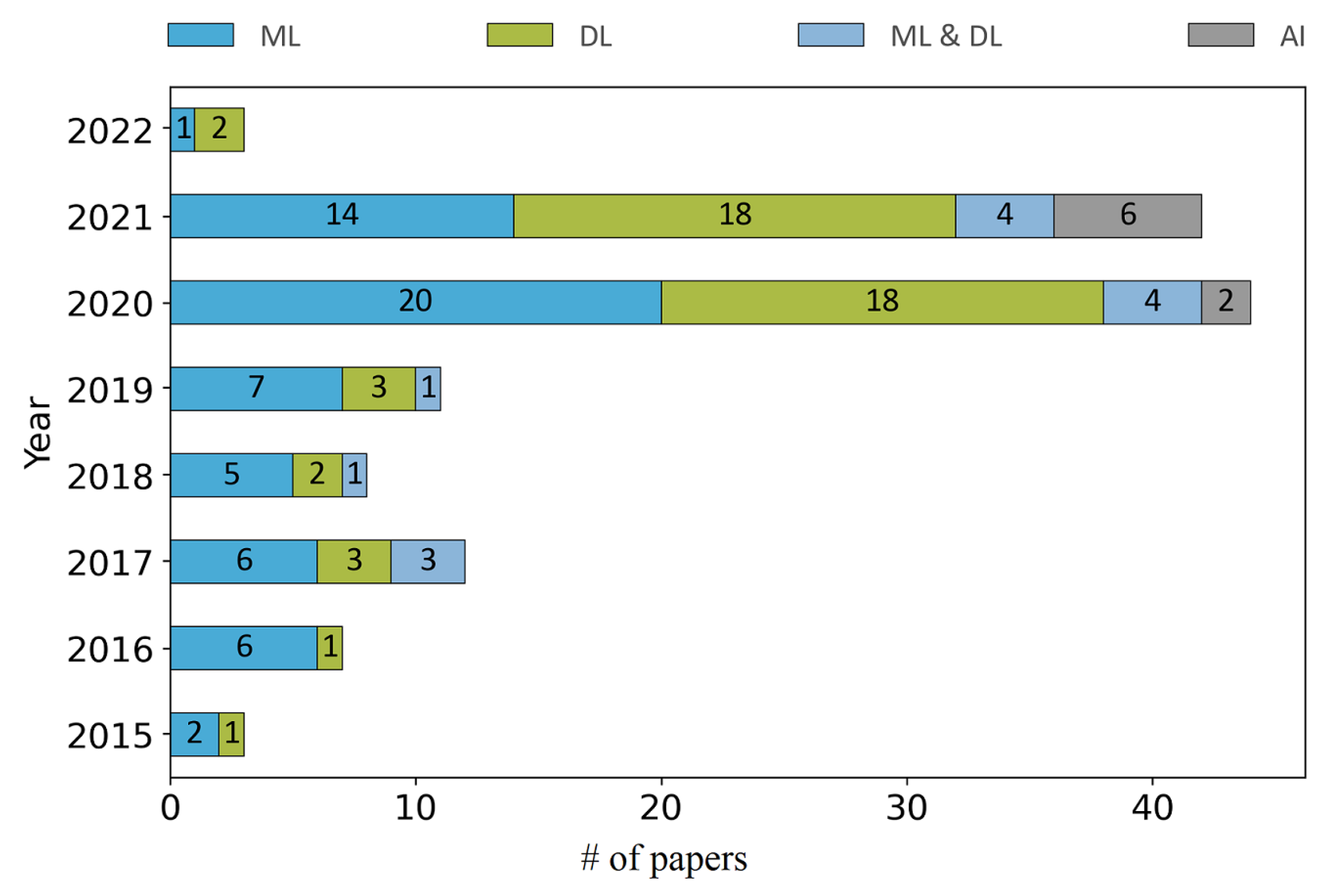
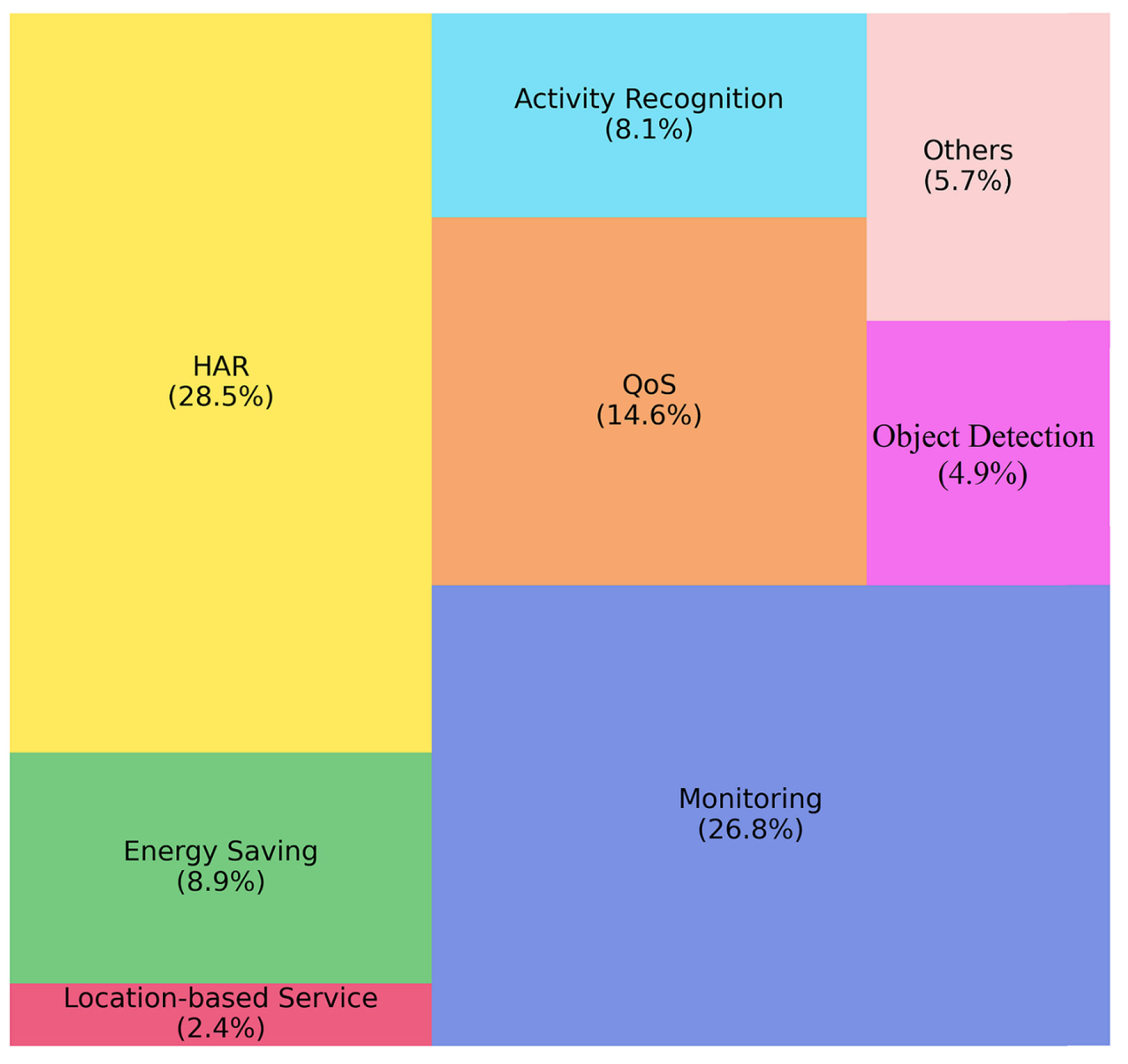


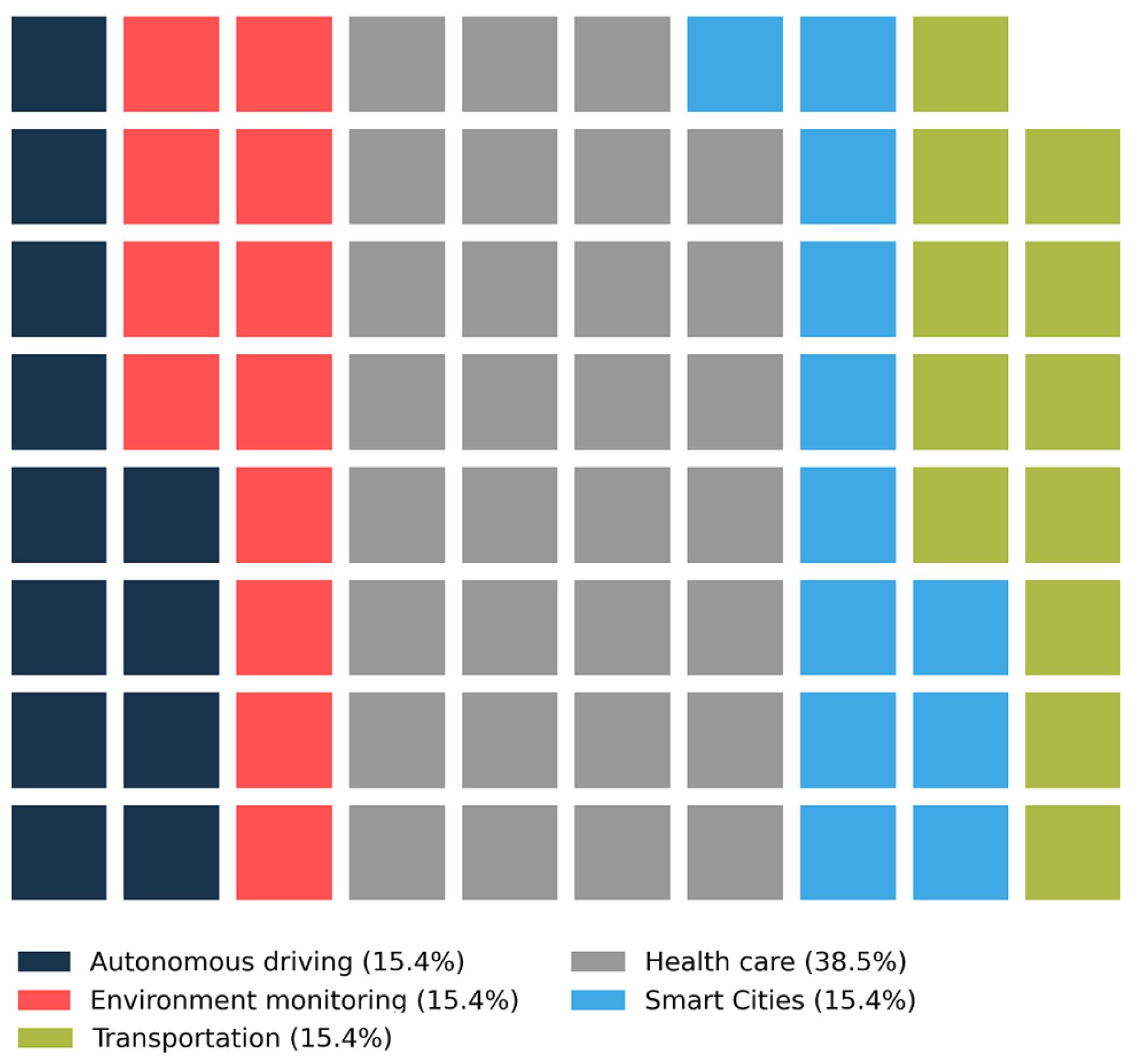





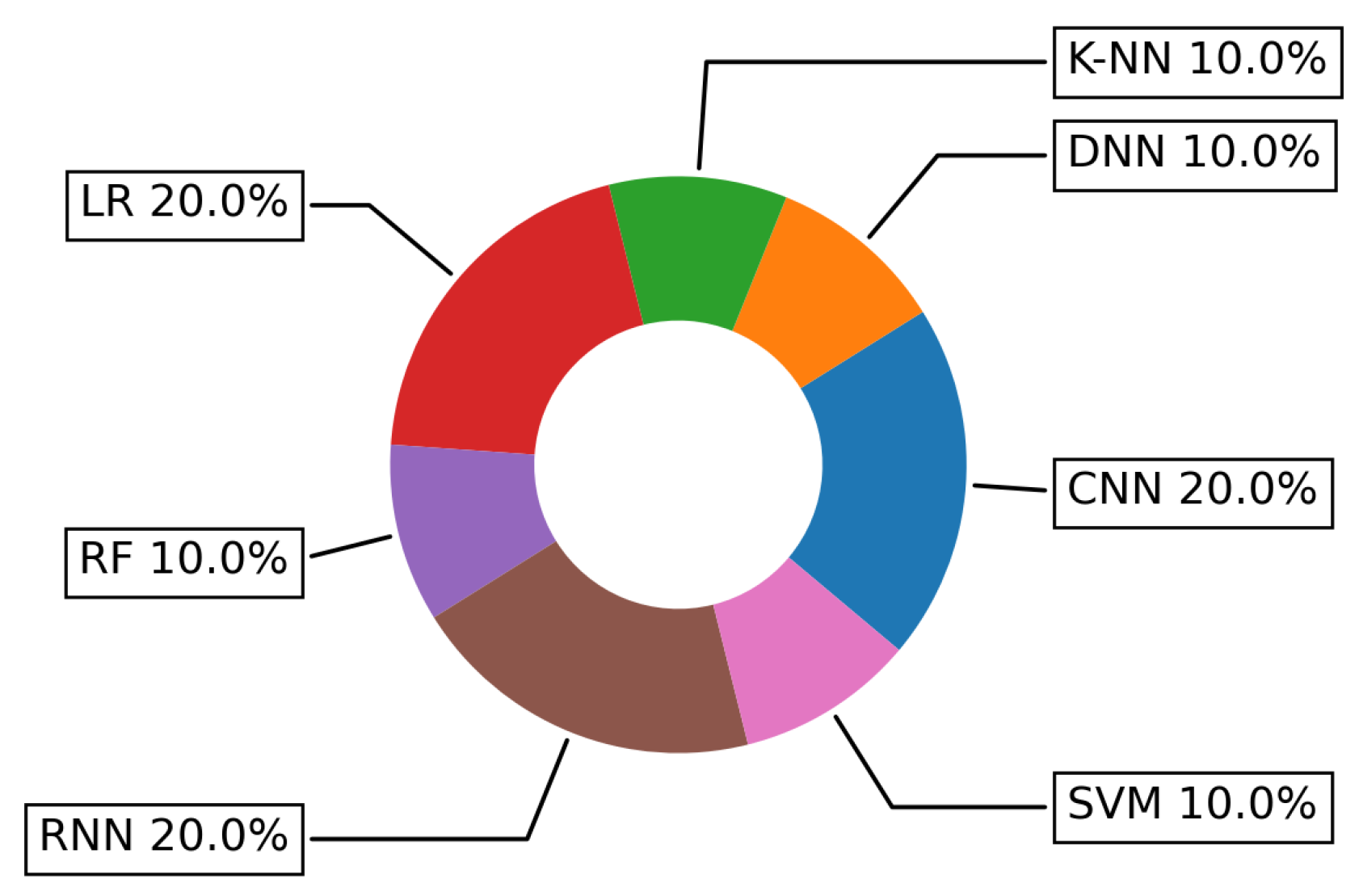

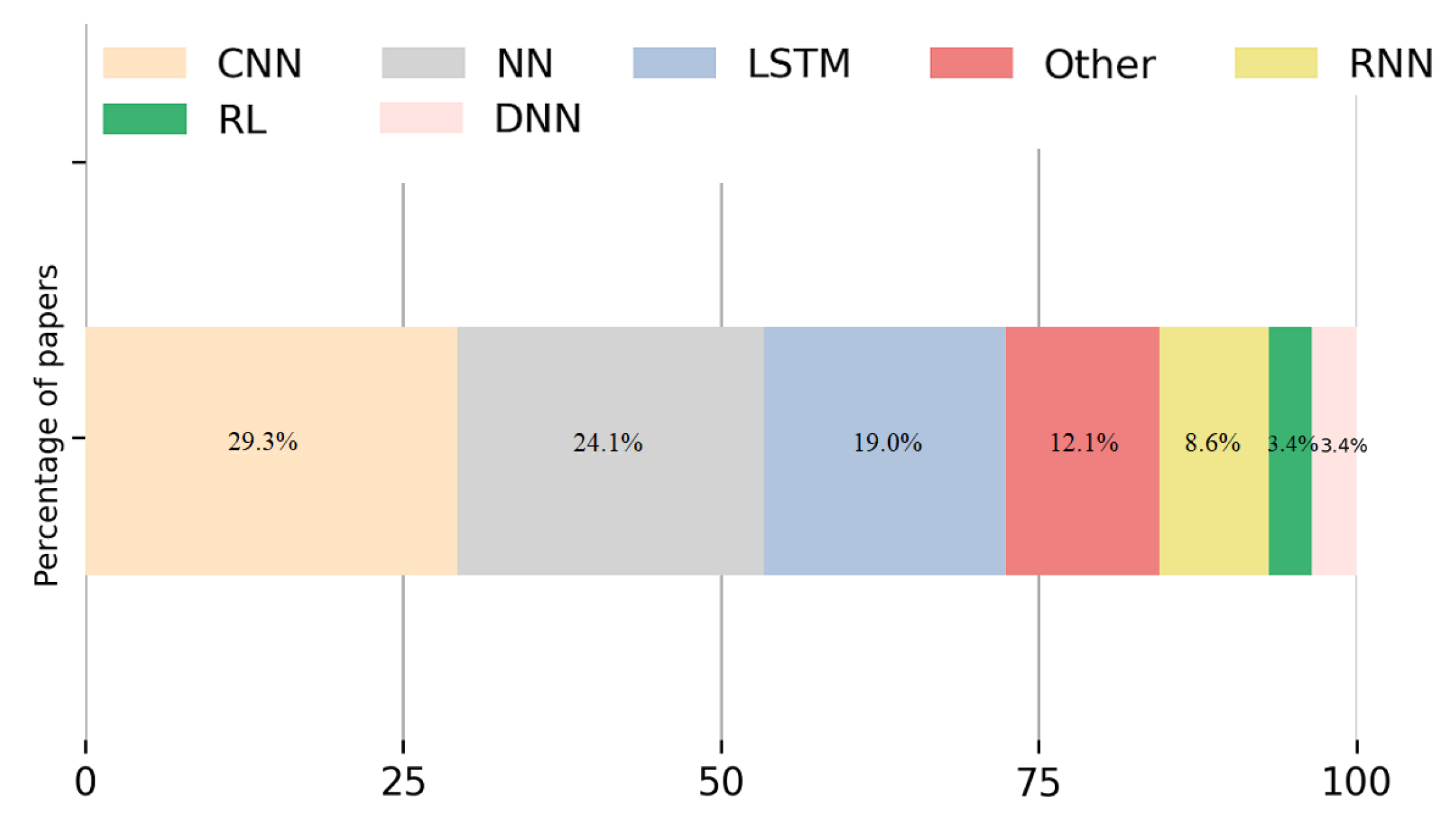

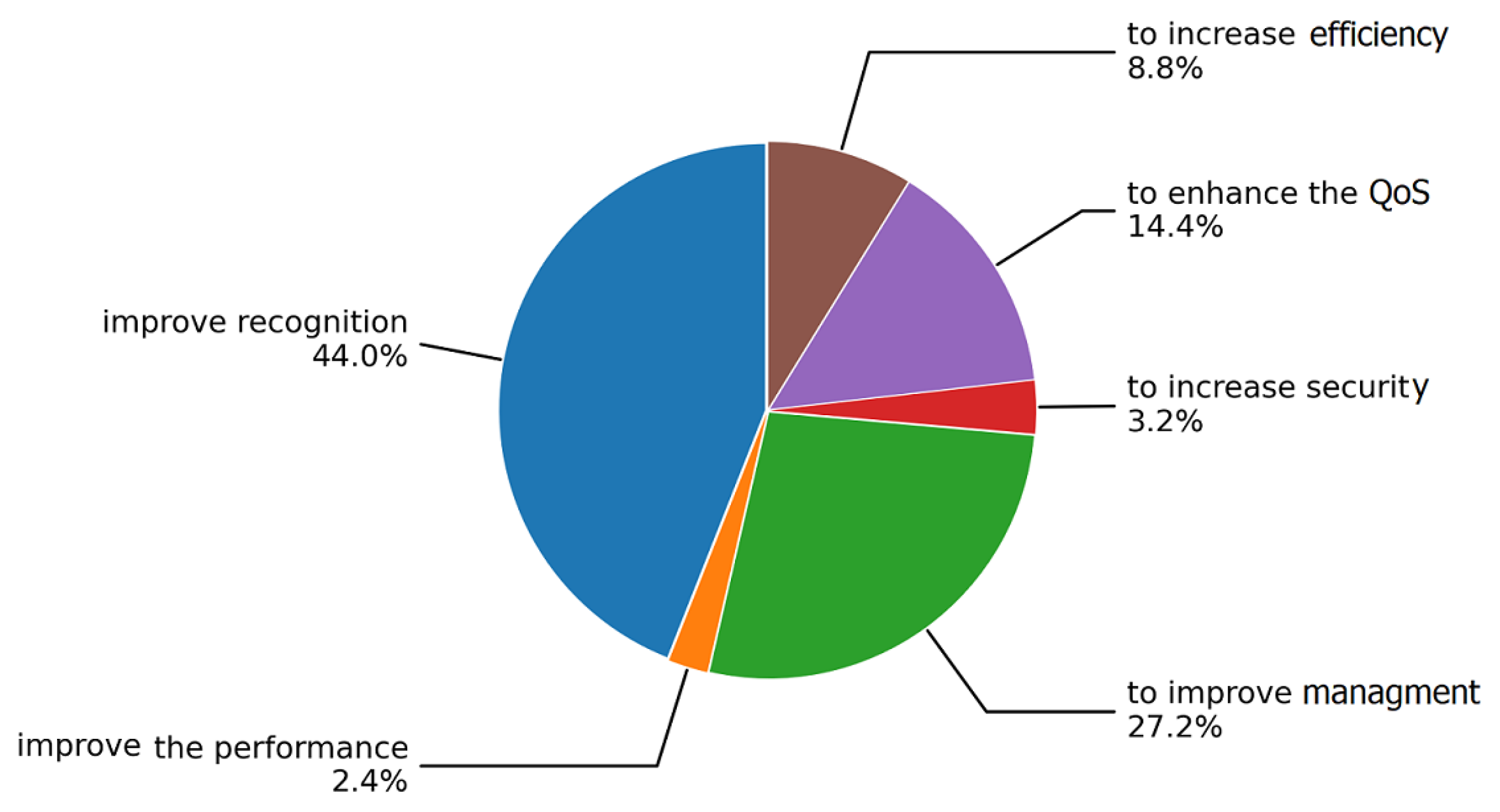

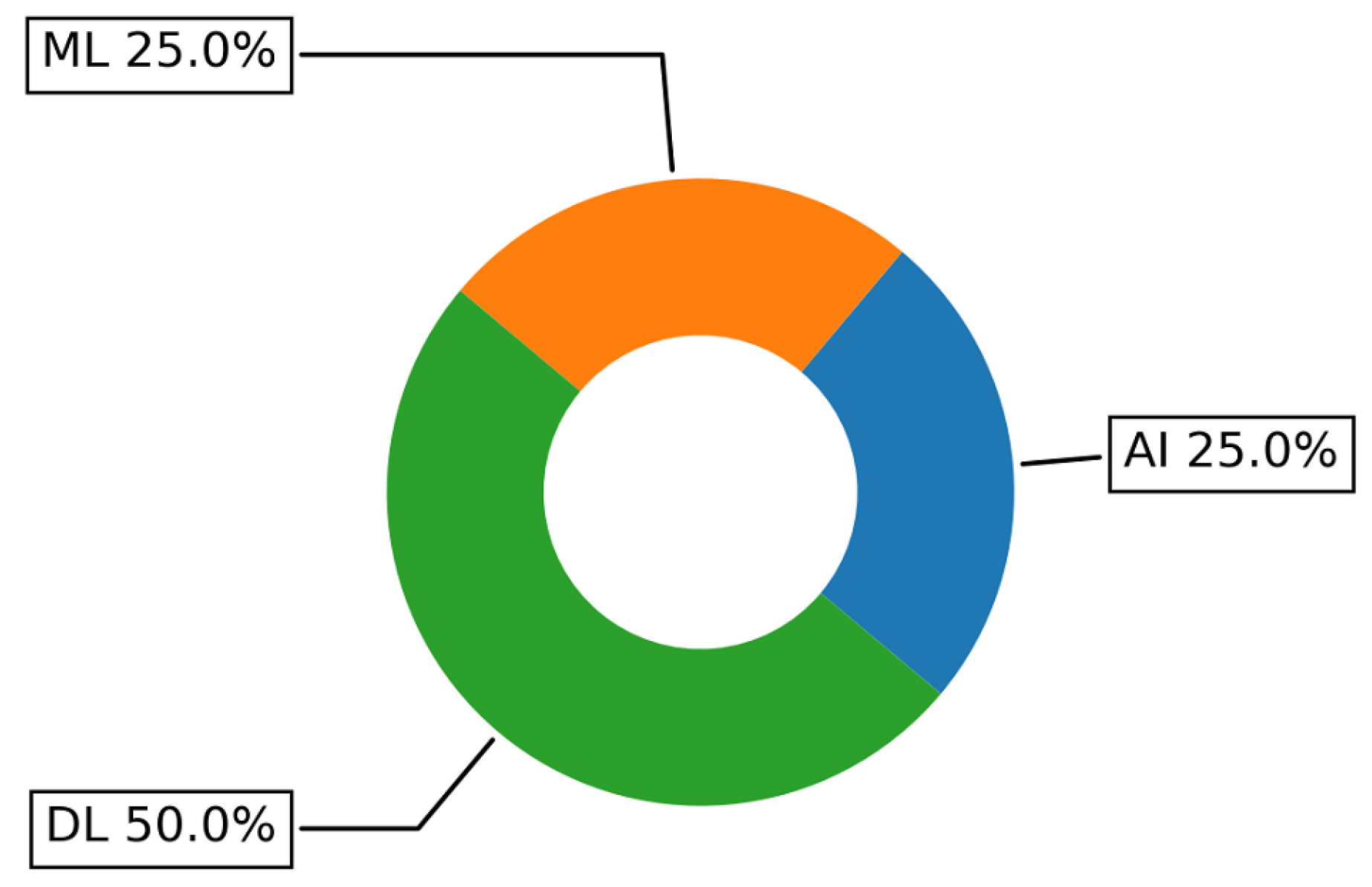
| Reference | Year | Main Focus | AI Techniques |
|---|---|---|---|
| [40] | 2015 | Evaluation of different available resources, | × |
| communication mediums, and frameworks | |||
| for industrial market perspective. | |||
| [41] | 2016 | A context-aware review for recognizing emerging | × |
| fields from a software development | |||
| point of view. | |||
| [42] | 2019 | A survey study about context-aware crowd | × |
| sensing systems for urban environments. | |||
| [43] | 2022 | A survey on the use of ML methods in context- | AI, ML and DL |
| aware middlewares for HAR. | |||
| [44] | 2018 | A survey on context awareness for IoT big data analysis. | AI, ML and DL |
| [45] | 2018 | A comprehensive survey on the utilization of AI | AI, ML and DL |
| integrating ML, data analytics, and NLP techniques | |||
| for enhancing the efficiency of wireless networks. | |||
| [46] | 2019 | A literature analysis of various context-aware systems | × |
| (modelling, organization, and middleware). | |||
| [47] | 2019 | A short survey of the latest development | AI, ML and DL |
| of context-aware systems. | |||
| [48] | 2019 | A survey of recent advances in intelligent sensing, | AI, ML and DL |
| computation, communication, and energy | |||
| management for resource-constrained | |||
| IoT sensor nodes. | |||
| [49] | 2021 | An extensive survey of AI-based mobile context- | AI, ML and DL |
| aware recommender systems. | |||
| Our Paper | 2022 | A broad study of the adoption | AI, ML and DL |
| of edge-based AI solutions for context- | |||
| awareness in WSNs. |
| ID | Question |
|---|---|
| Q1 | How much literature activity has there been between 2015 and January 2022? |
| Q2 | What are the challenges in context-aware edge-based AI for sensor networks? |
| Q3 | What are the state-of-the-art solutions used to address the challenges depending on |
| the specific application field? | |
| Q4 | What are the motivations to adopt AI solutions to context awareness scenario? |
| Q5 | What are the limitations of current literature or what are gaps existing in the current |
| research about applying AI technologies to context awareness that future | |
| researchers can investigate? |
| Scientific Database | Search String |
|---|---|
| Scopus | TITLE-ABS-KEY ((“Context*” OR “aware*”) AND (*edge |
| OR device) AND (“artificial intelligence” OR “machine | |
| learning” OR “deep learning”) AND (“sensor*”)) | |
| Web of Science | TS = ((“Context*“ OR “aware*”) AND (*edge OR device) |
| AND (“artificial intelligence” OR “machine learning” | |
| OR “deep learning”) AND (“sensor*”)) |
| Cluster Label | Size | Keywords |
|---|---|---|
| AI, ML and DL | 27 | active learning, AI, ANN, attention mechanism, big data, classification, CNN, data mining, data models, DL, DNN, feature extraction, feature selection, inference, intelligent systems, LSTM, ML, prediction, predictive models, RF, RNN, regression, RL, supervised learning, SVM, time-series classification, training. |
| Edge Computing and Smart Monitoring | 11 | EC, pervasive computing, biomedical monitoring, ECG, electrocardiography, health monitoring, heart rate, monitoring, pervasive healthcare, physiological signals, physiology. |
| Smart Healthcare | 10 | accelerometer, action recognition, activity recognition, gait recognition, HAR, mhealth, mobile computing, mobile health, mobile sensing, smart healthcare. |
| Smart and Wearable Devices | 8 | on-device computation smart devices, smartphone, wearable computing, wearable devices, wearable sensors, wearable system, wearables. |
| Anticipatory Computing and SSL | 4 | anticipatory computing, recommendation system, semi-supervised learning, transfer learning. |
| Context-Awareness | 4 | context modeling, context-aware systems, context-awareness, context-awareness services. |
| Energy Consumption and Saving | 4 | energy consumption, energy efficiency, energy saving, power consumption. |
| IoT | 4 | industry 4.0, IoMT, IoT, smart home. |
| Sensors and WSN | 4 | WSN, sensor data, sensor fusion, sensors. |
| Mental Health | 3 | mental health, stress, stress monitoring. |
| Computer Vision | 3 | computer vision, object recognition, pattern recognition. |
| Keyword | Occurrences |
|---|---|
| ML | 55 |
| DL | 27 |
| IoT | 22 |
| activity recognition | 17 |
| sensors | 12 |
| HAR | 10 |
| wearable sensors | 10 |
| CNN | 8 |
| classification | 7 |
| context-awareness | 7 |
| Main Subject | References | # of Studies |
|---|---|---|
| Smart Healthcare | [54,55,56,57,58,59,60,61,62,63,64,65,66,67,68,69,70,71,72,73,74,75,76,77,78,79,80,81,82,83,84,85,86,87,88] | 35 |
| AI, ML and DL | [56,59,63,76,78,82,88,89,90,91,92,93,94,95,96,97,98,99,100,101,102,103,104,105,106,107,108,109,110,111,112,113,114] | 34 |
| Smart and Wearable Devices | [54,55,56,59,60,61,66,67,78,80,83,86,87,88,89,98,106,109,115,116,117,118,119,120,121,122,123,124,125,126,127] | 31 |
| Sensors and WSN | [60,61,76,77,80,83,91,101,104,109,112,113,115,127,128,129,130] | 17 |
| Edge Computing and Smart Monitoring | [56,60,67,85,98,106,113,114,117,131,132,133,134,135,136,137] | 16 |
| Context-Awareness | [57,65,68,70,76,81,91,93,134,138,139,140,141] | 13 |
| Energy Consumption and Saving | [62,63,92,130,137,142,143,144] | 8 |
| Anticipatory Computing and SSL | [57,62,68,76,83,119,145] | 7 |
| IoT | [77,105,146,147,148,149] | 6 |
| Computer Vision | [87,99,150,151,152] | 5 |
| Mental Health | [61,80,114,117,136] | 5 |
| Reference | ML | DL |
|---|---|---|
| [60] | SVR, RF, GP, LR, K-NN | ANN |
| [136] | SVM, J48, RF, NB | NN |
| [119] | semi-supervised k-means | DNN |
| [120] | DT, Discriminant Analysis, SVM, K-NN, NB | NN |
| [176] | Gaussian mixture models | DNN, RNN |
| [64] | SVM | NN |
| [65] | RF, DT | NN |
| [66] | LR | RNN |
| [121] | RF, SVM, K-NN, SGD, LR, NB, ET | DF |
| [97] | SVM | NN |
| [177] | SVM | MLP, LSTM, CNN |
Publisher’s Note: MDPI stays neutral with regard to jurisdictional claims in published maps and institutional affiliations. |
© 2022 by the authors. Licensee MDPI, Basel, Switzerland. This article is an open access article distributed under the terms and conditions of the Creative Commons Attribution (CC BY) license (https://creativecommons.org/licenses/by/4.0/).
Share and Cite
Al-Saedi, A.A.; Boeva, V.; Casalicchio, E.; Exner, P. Context-Aware Edge-Based AI Models for Wireless Sensor Networks—An Overview. Sensors 2022, 22, 5544. https://doi.org/10.3390/s22155544
Al-Saedi AA, Boeva V, Casalicchio E, Exner P. Context-Aware Edge-Based AI Models for Wireless Sensor Networks—An Overview. Sensors. 2022; 22(15):5544. https://doi.org/10.3390/s22155544
Chicago/Turabian StyleAl-Saedi, Ahmed A., Veselka Boeva, Emiliano Casalicchio, and Peter Exner. 2022. "Context-Aware Edge-Based AI Models for Wireless Sensor Networks—An Overview" Sensors 22, no. 15: 5544. https://doi.org/10.3390/s22155544
APA StyleAl-Saedi, A. A., Boeva, V., Casalicchio, E., & Exner, P. (2022). Context-Aware Edge-Based AI Models for Wireless Sensor Networks—An Overview. Sensors, 22(15), 5544. https://doi.org/10.3390/s22155544






